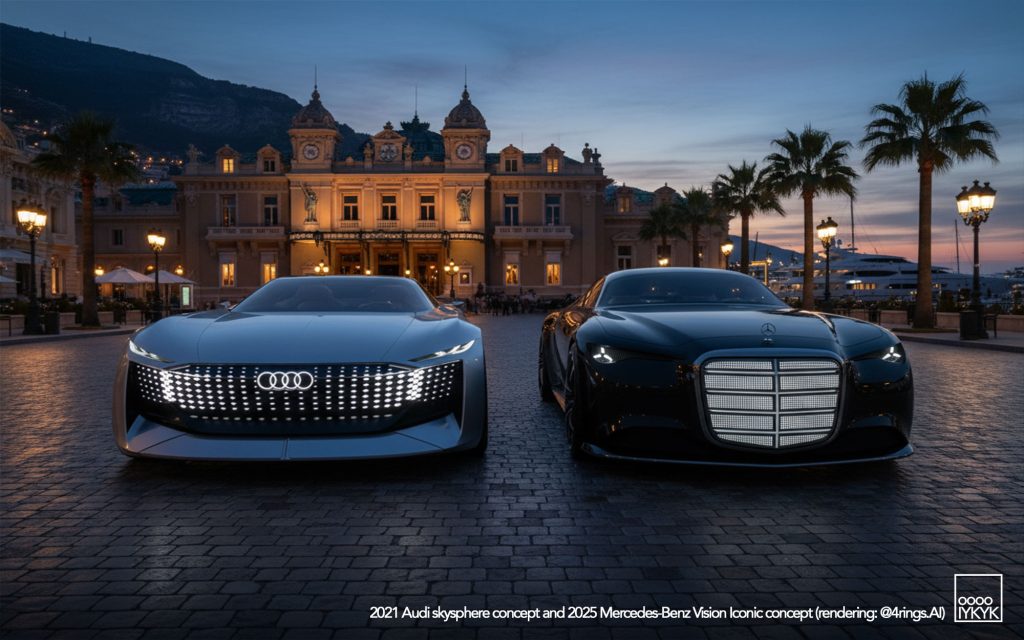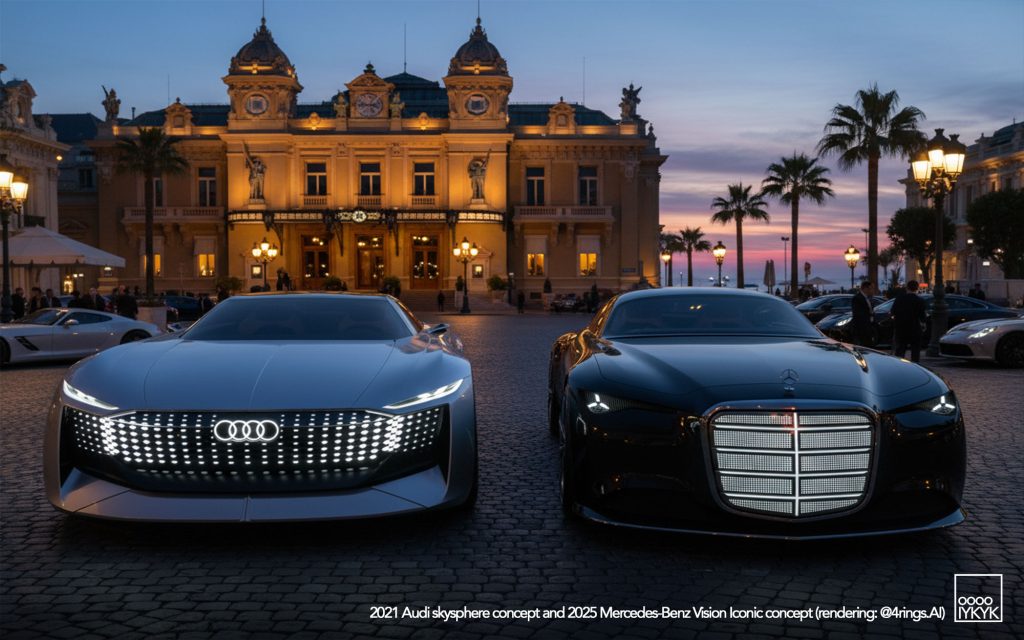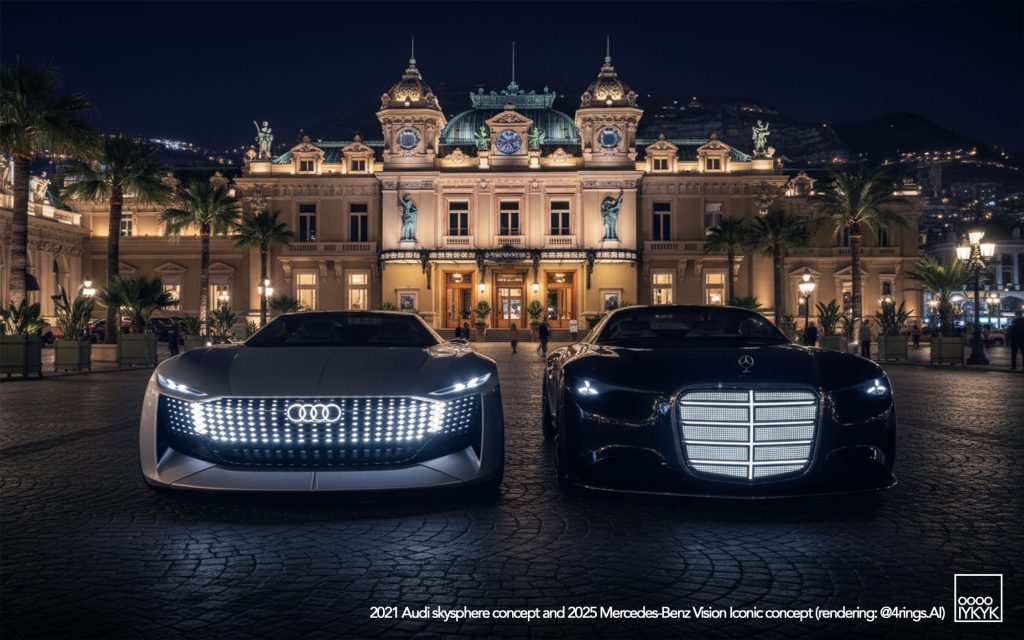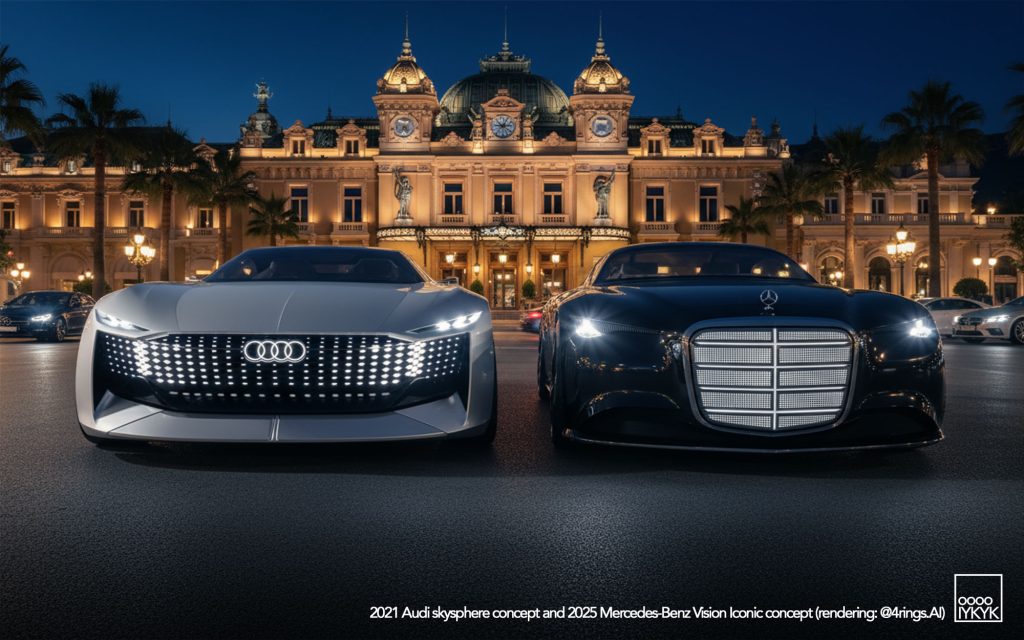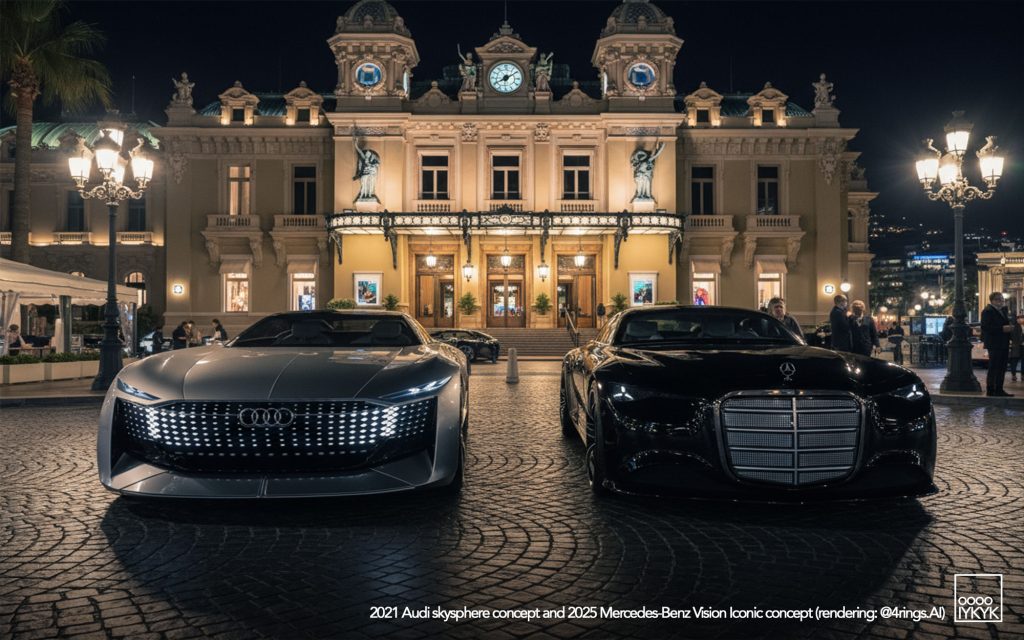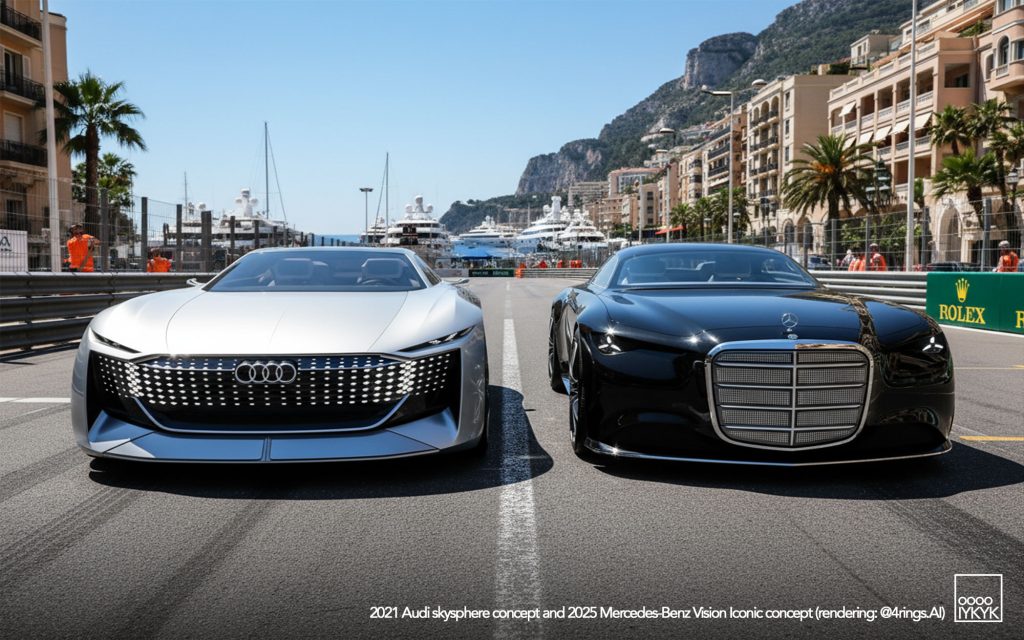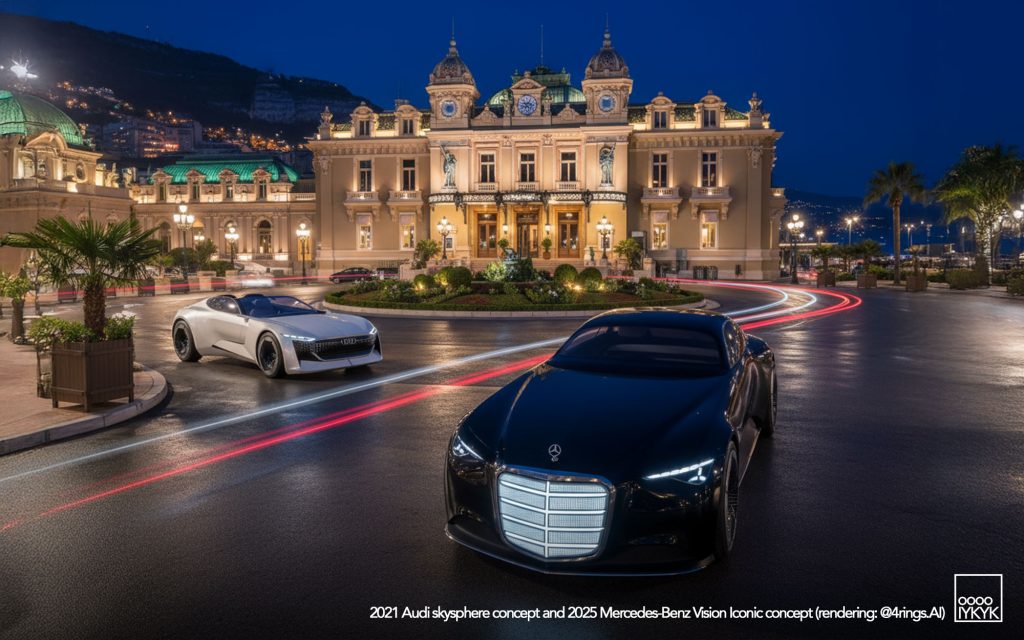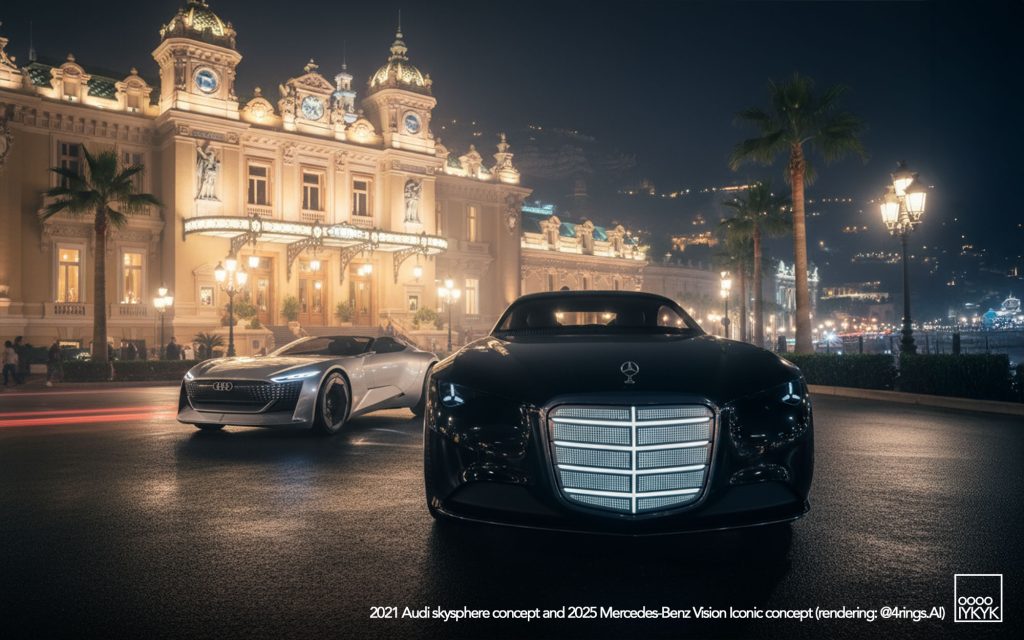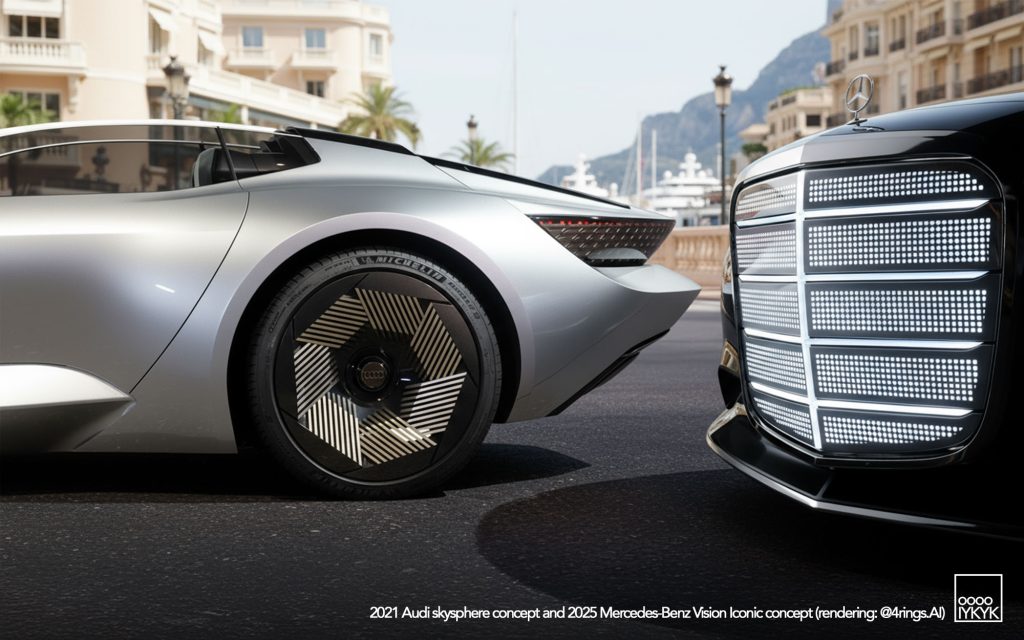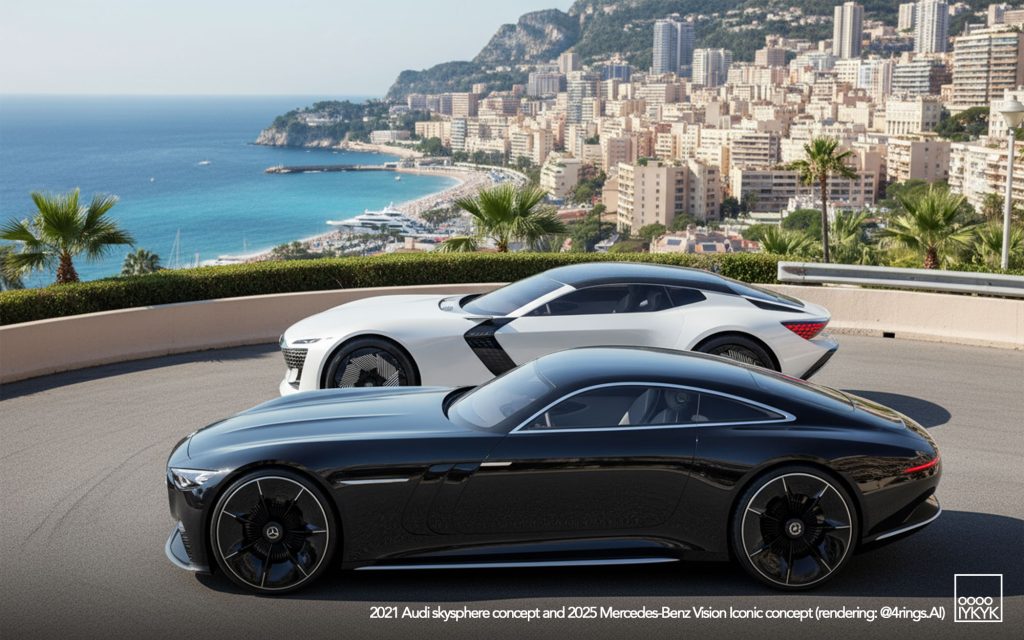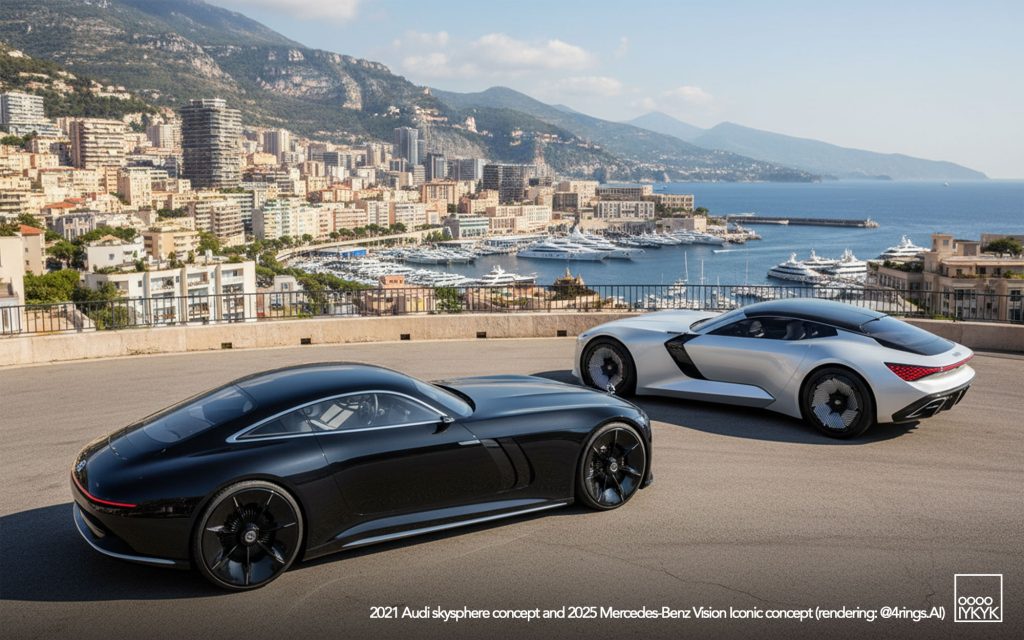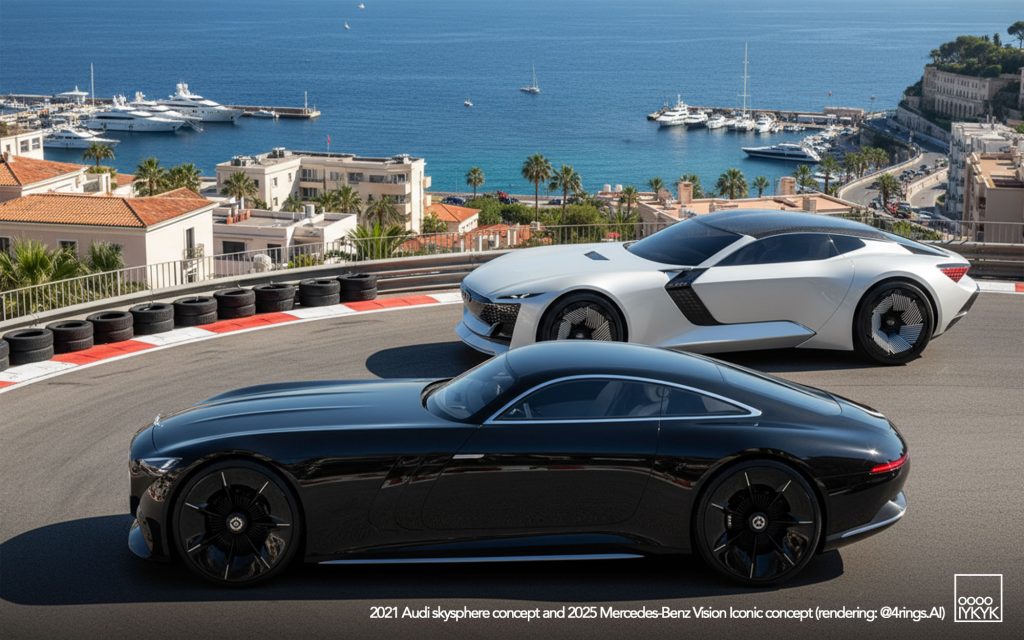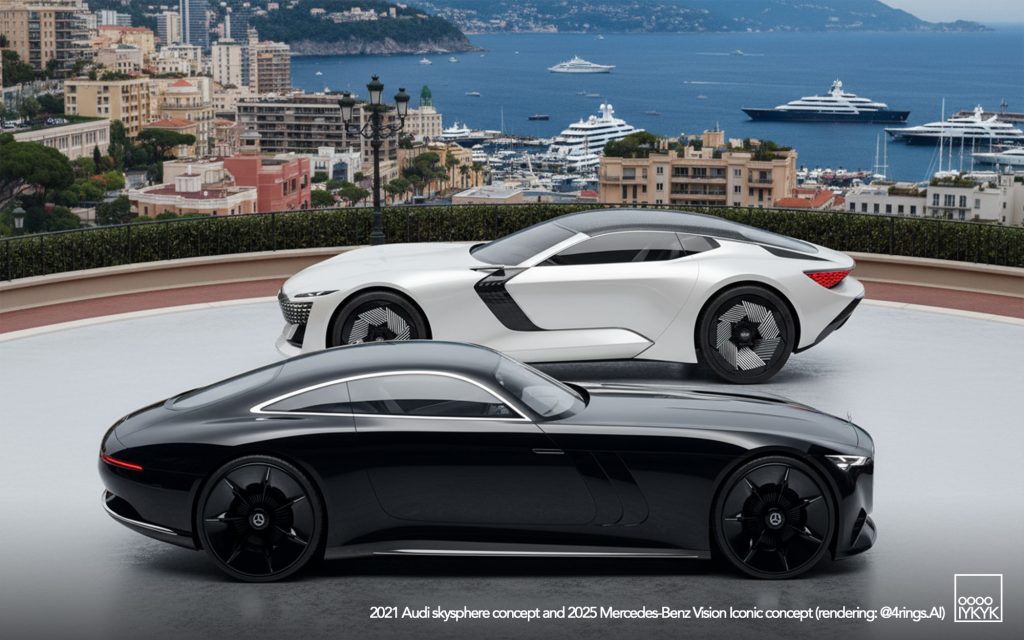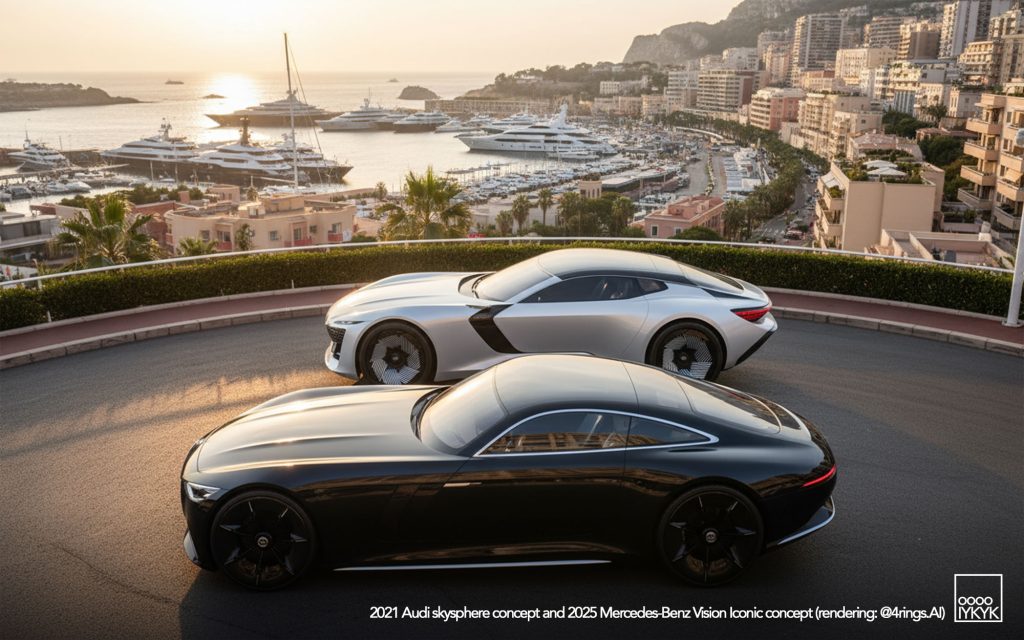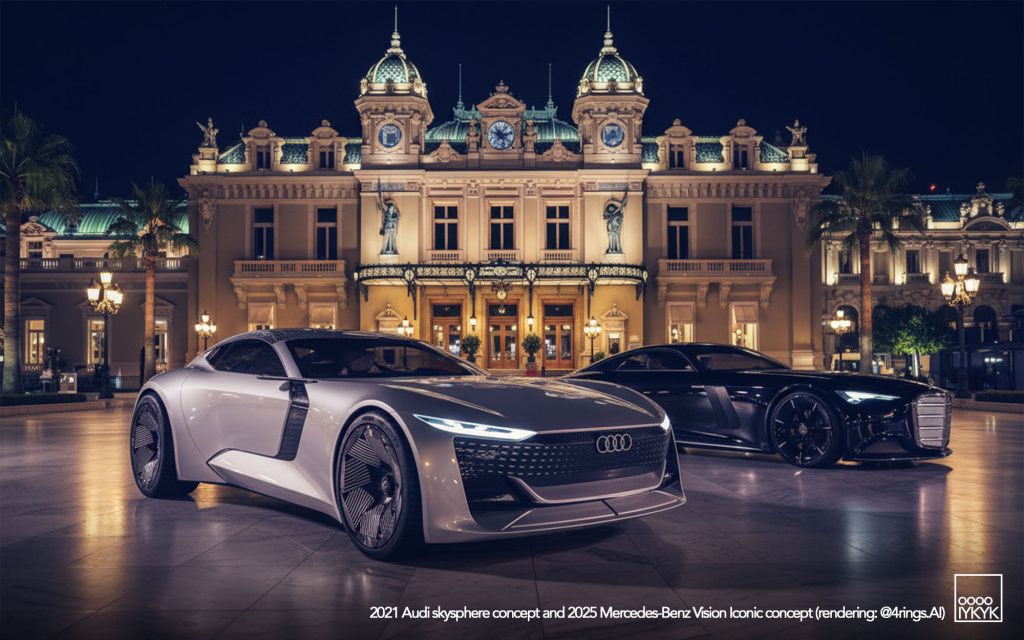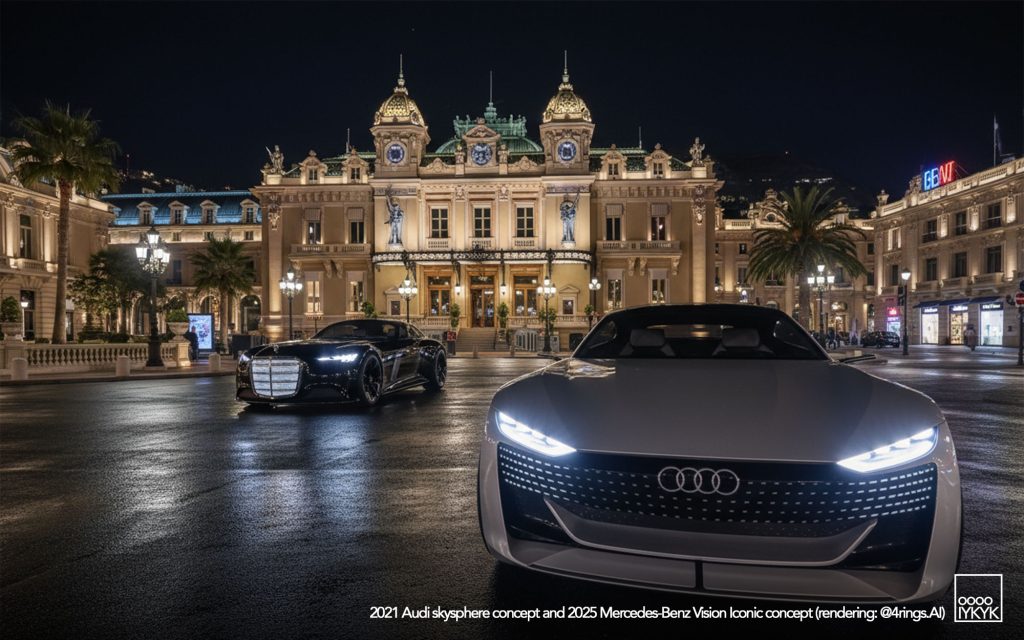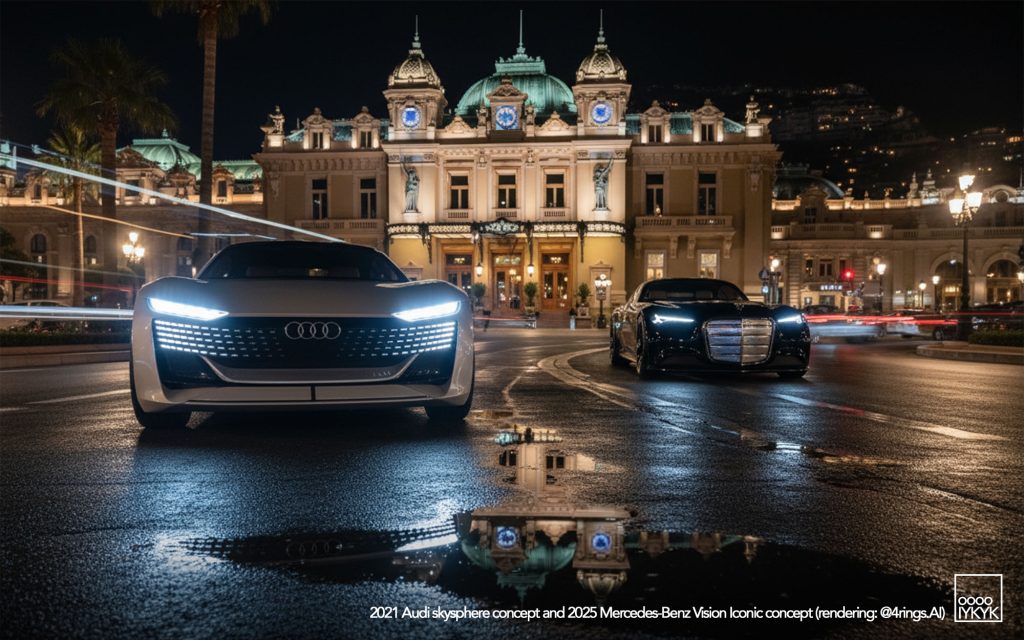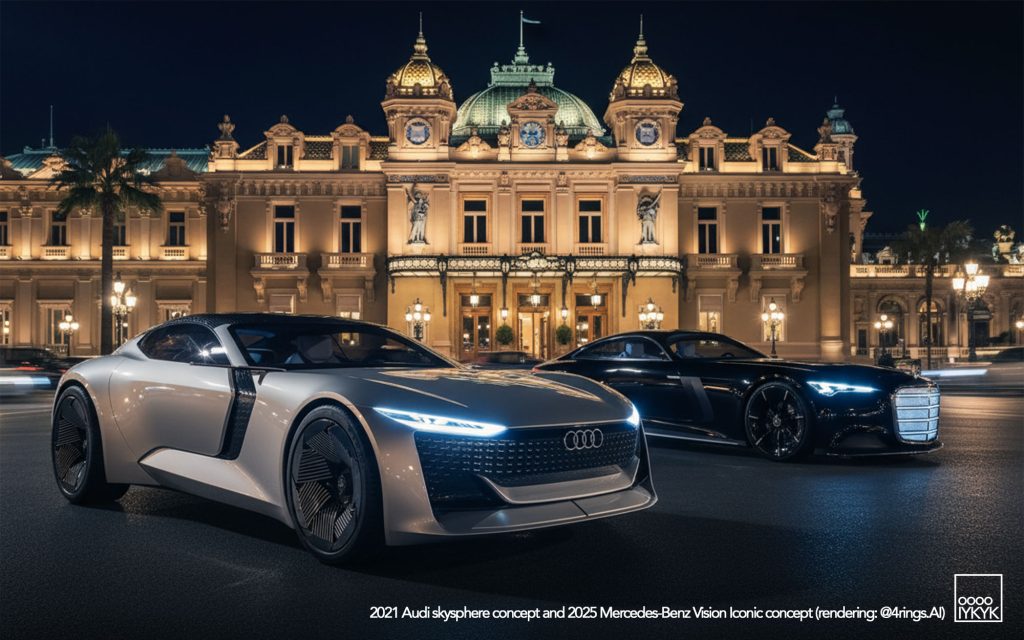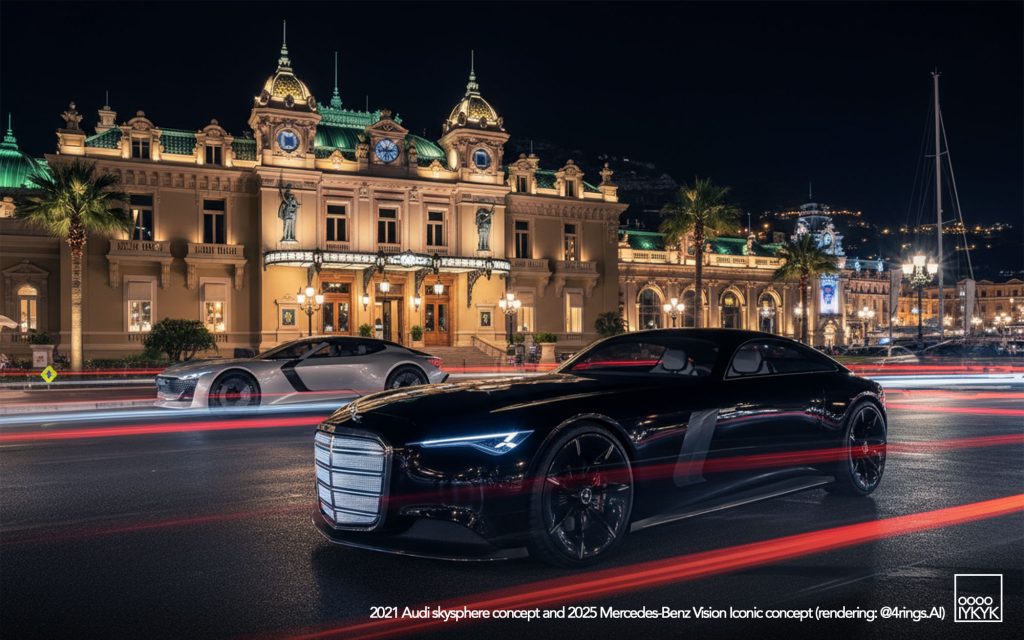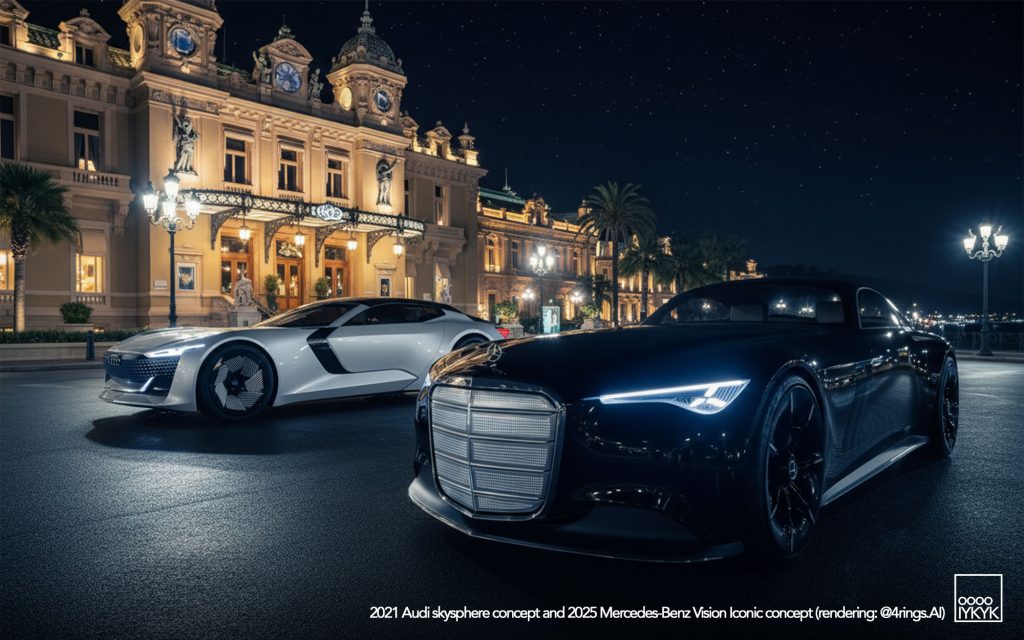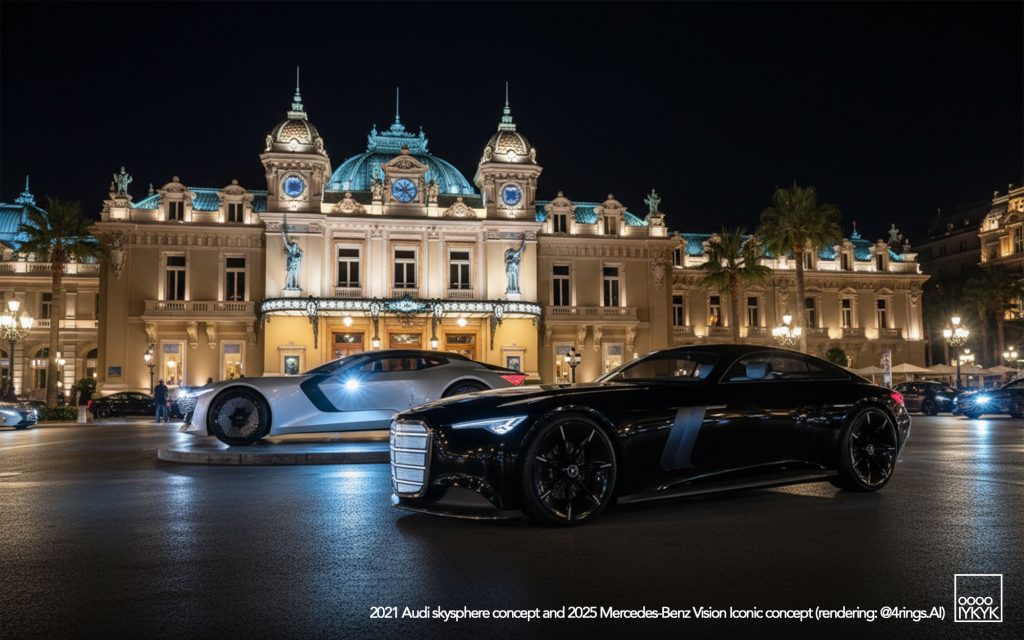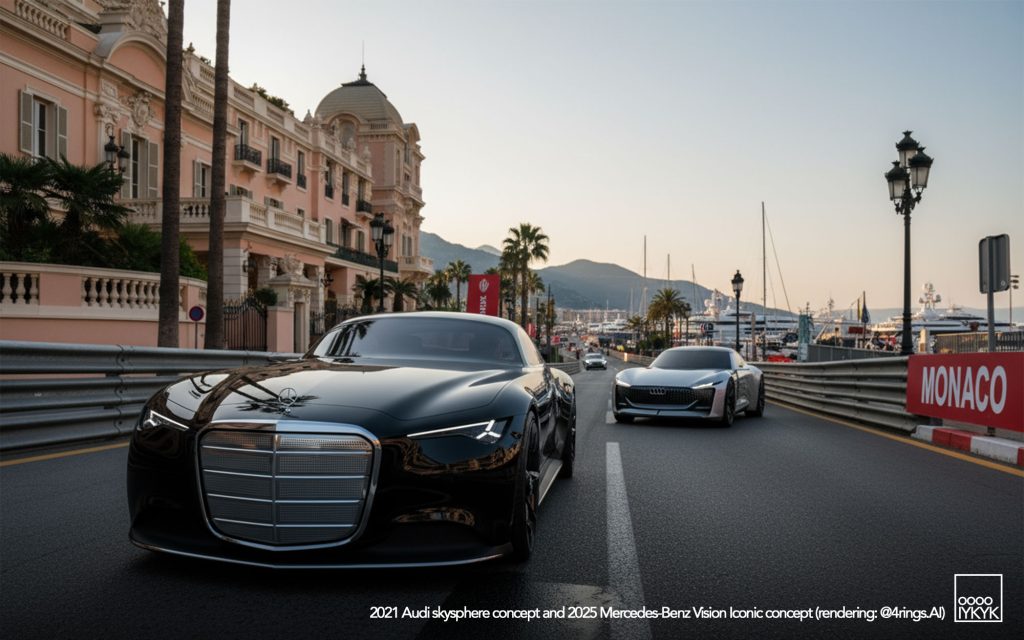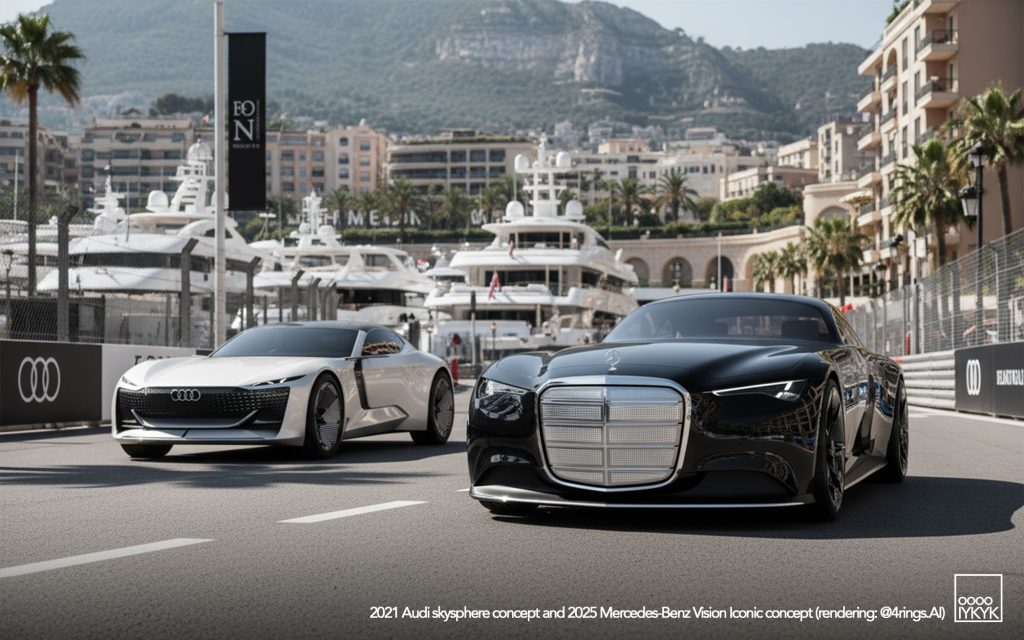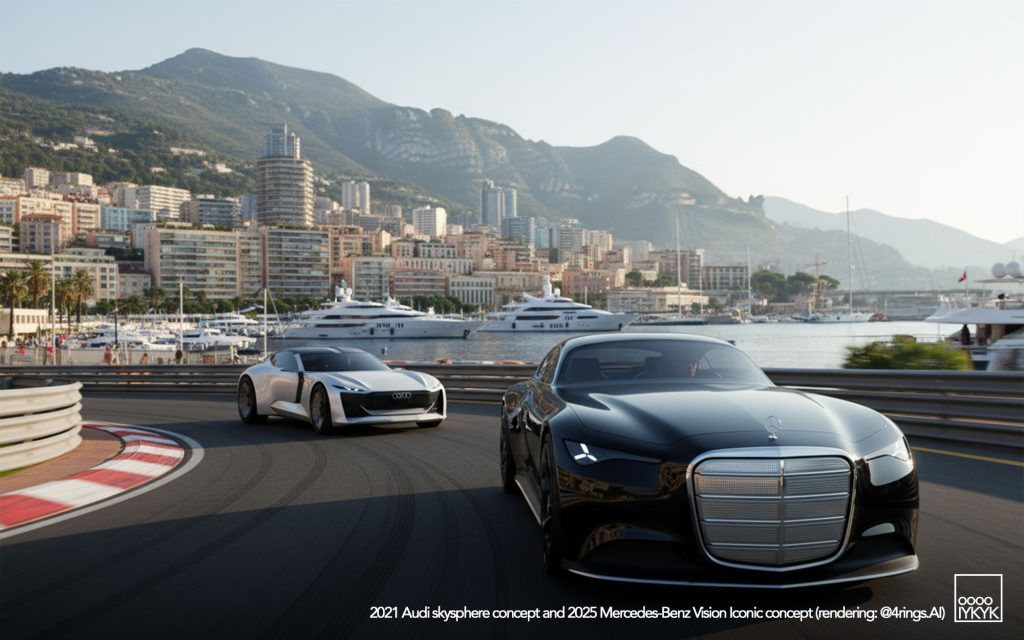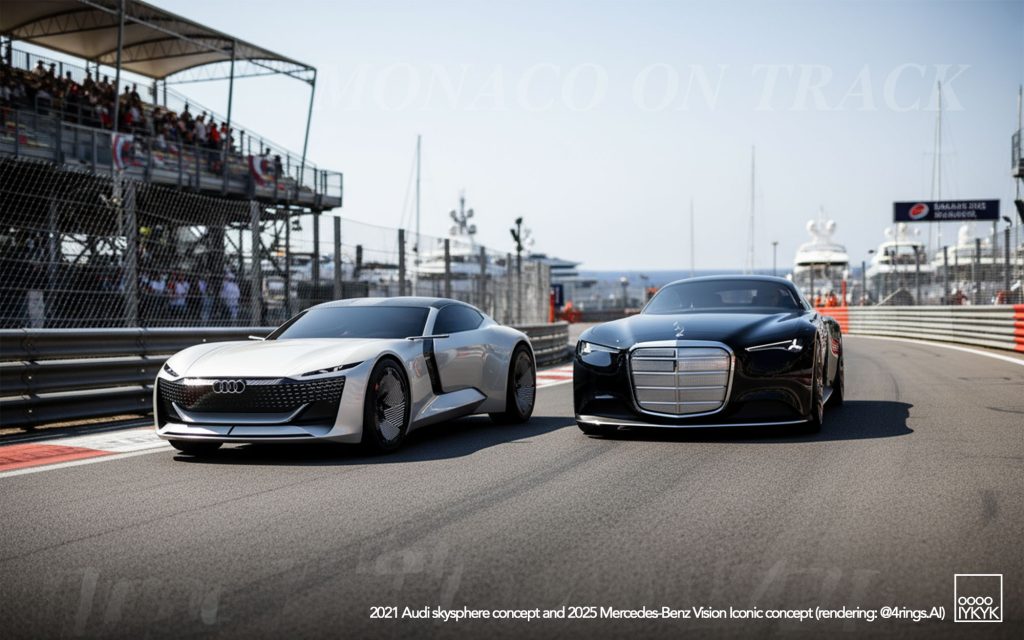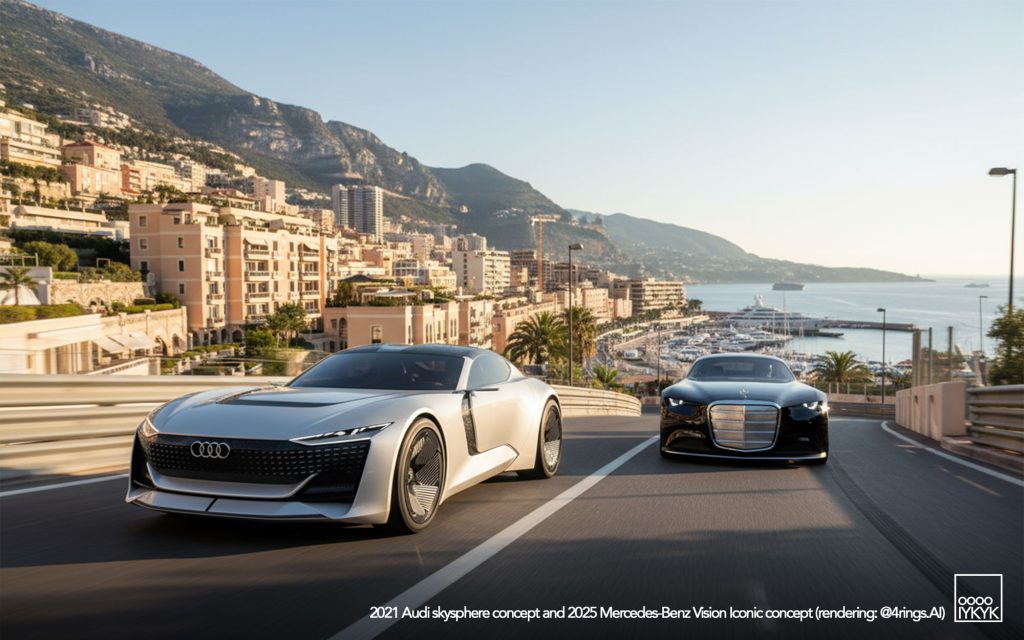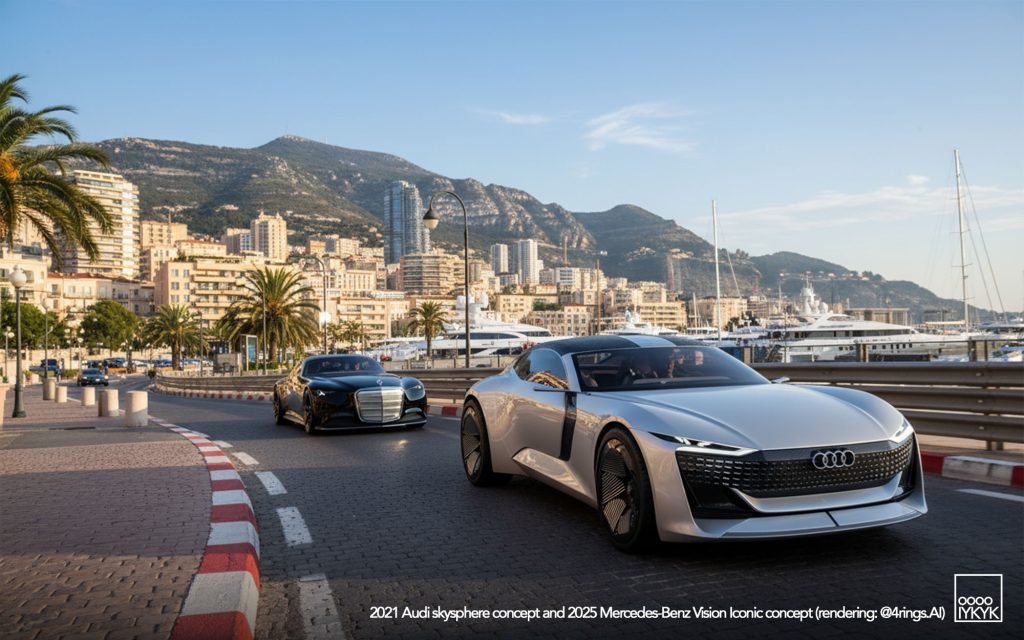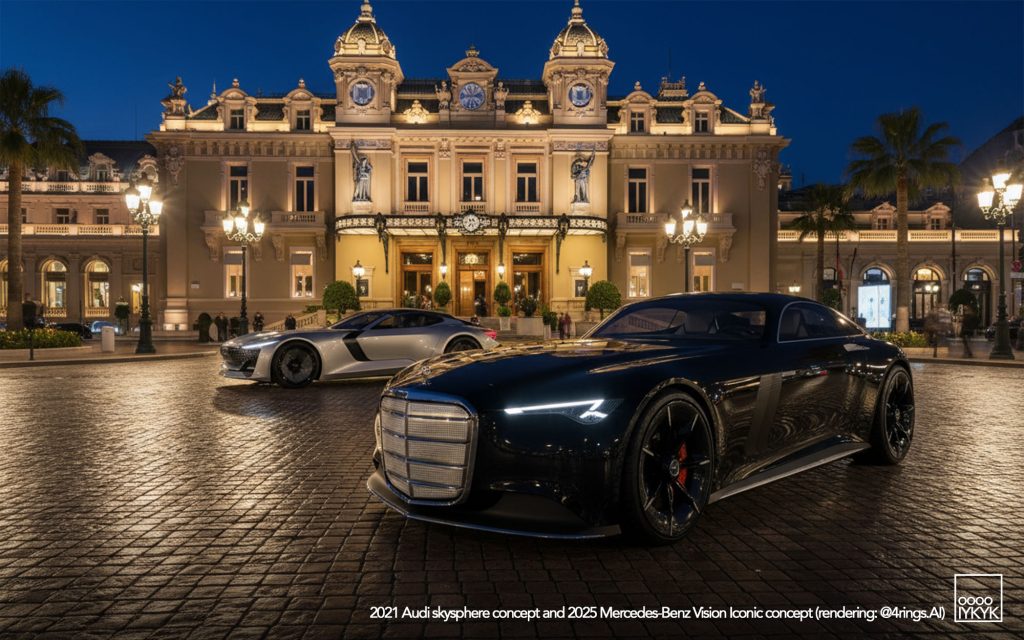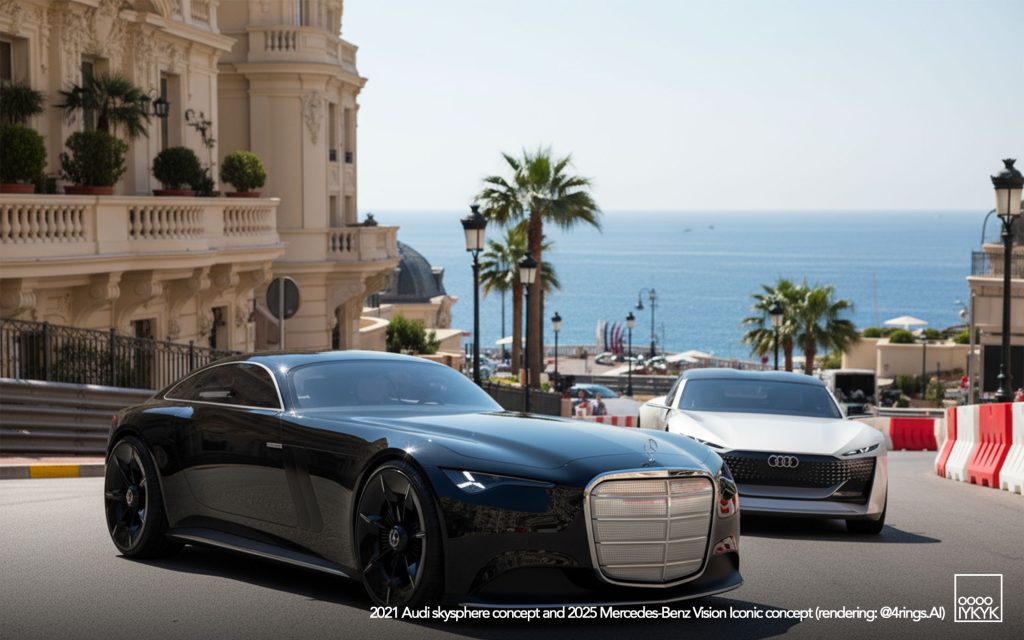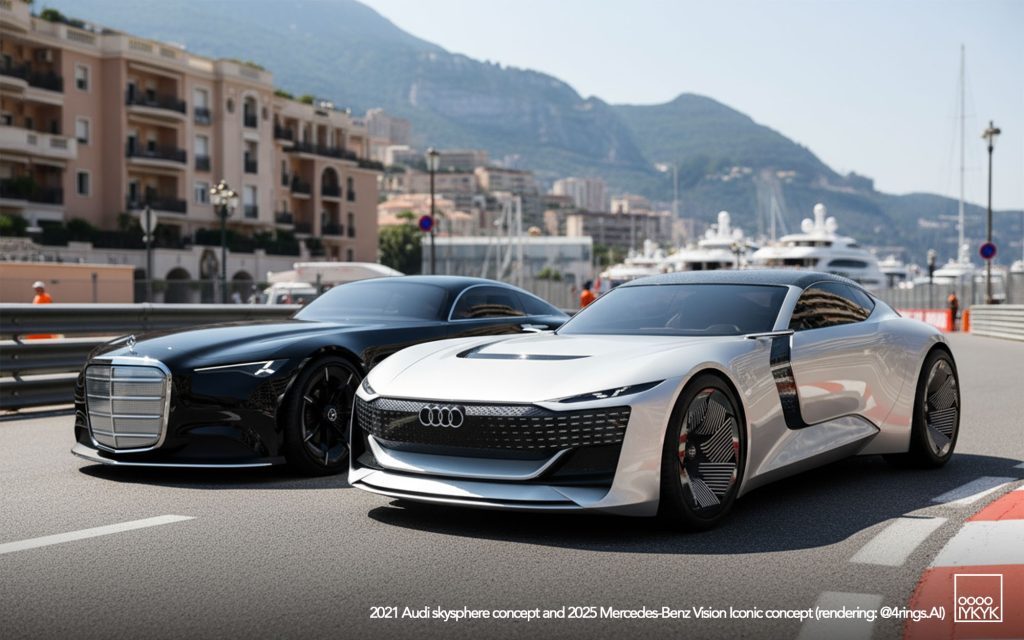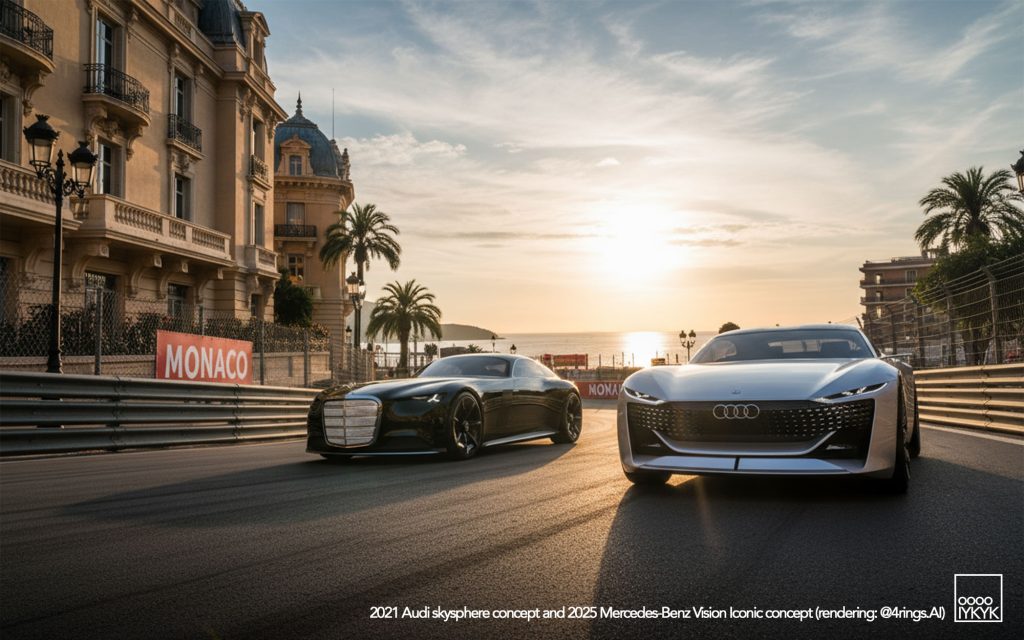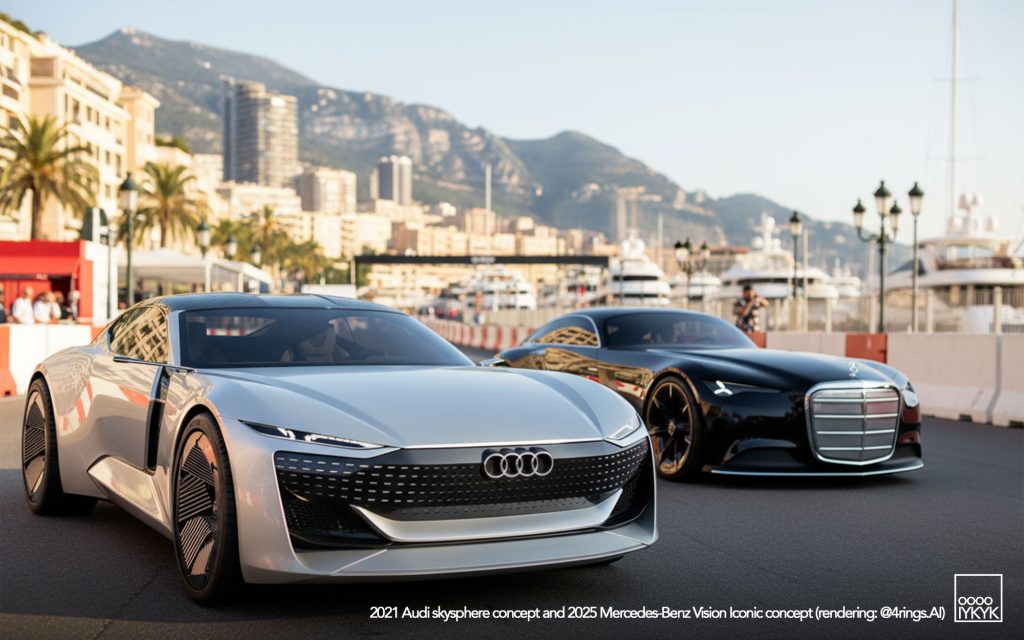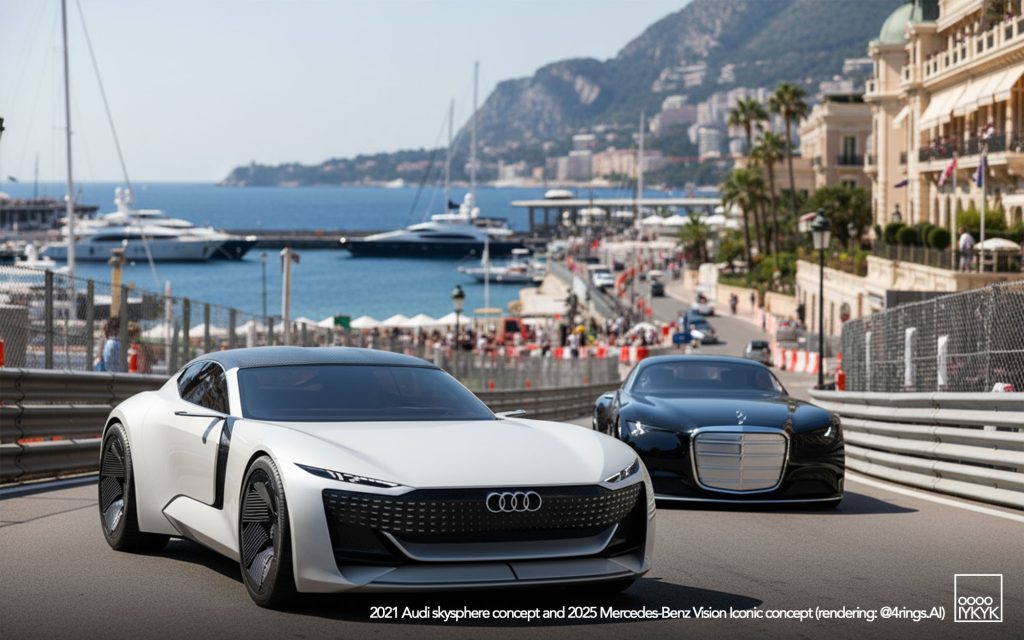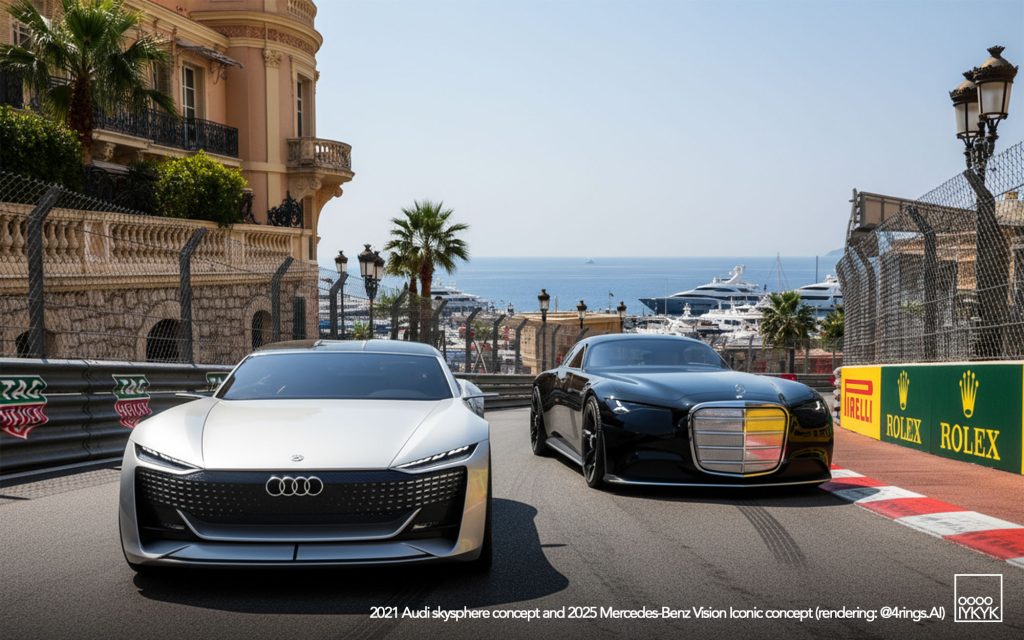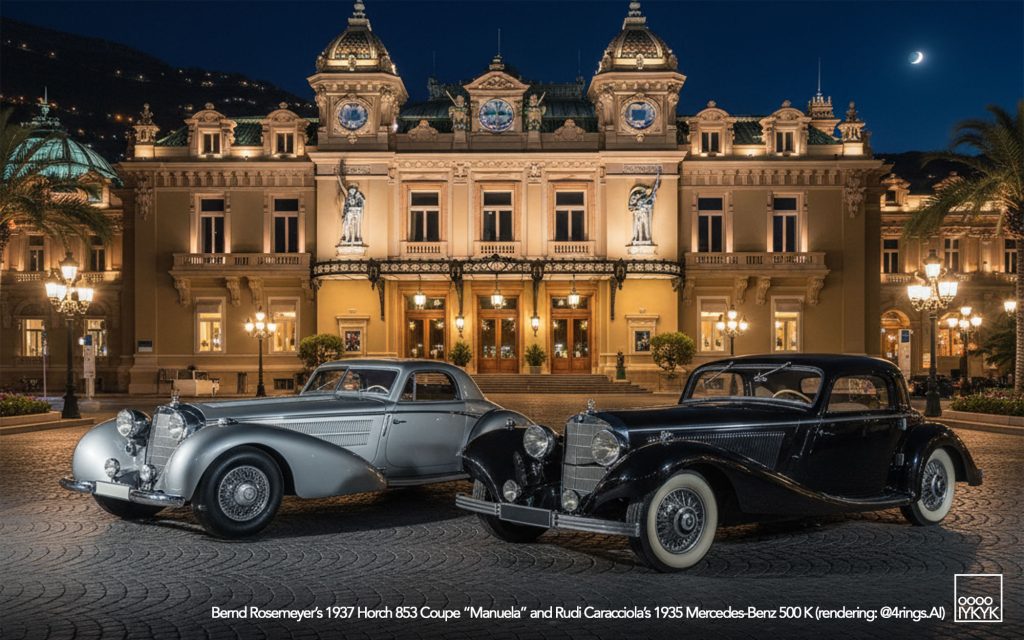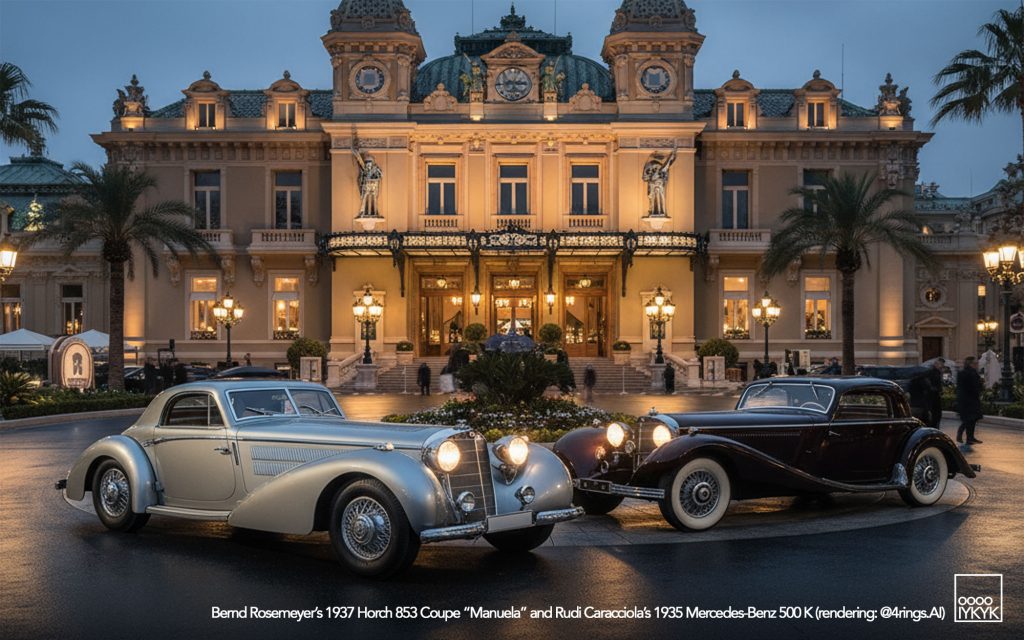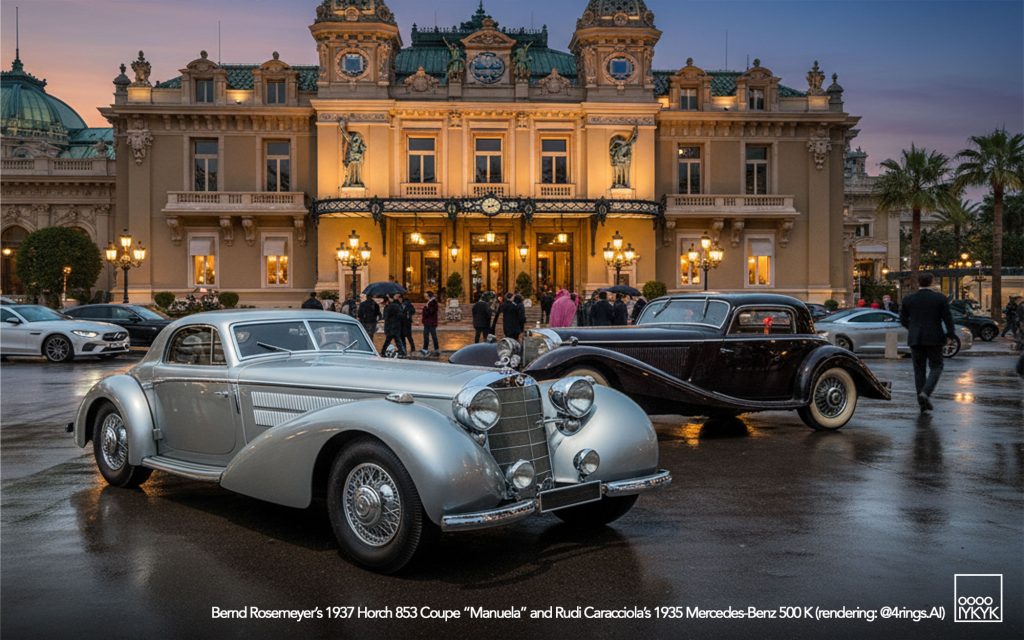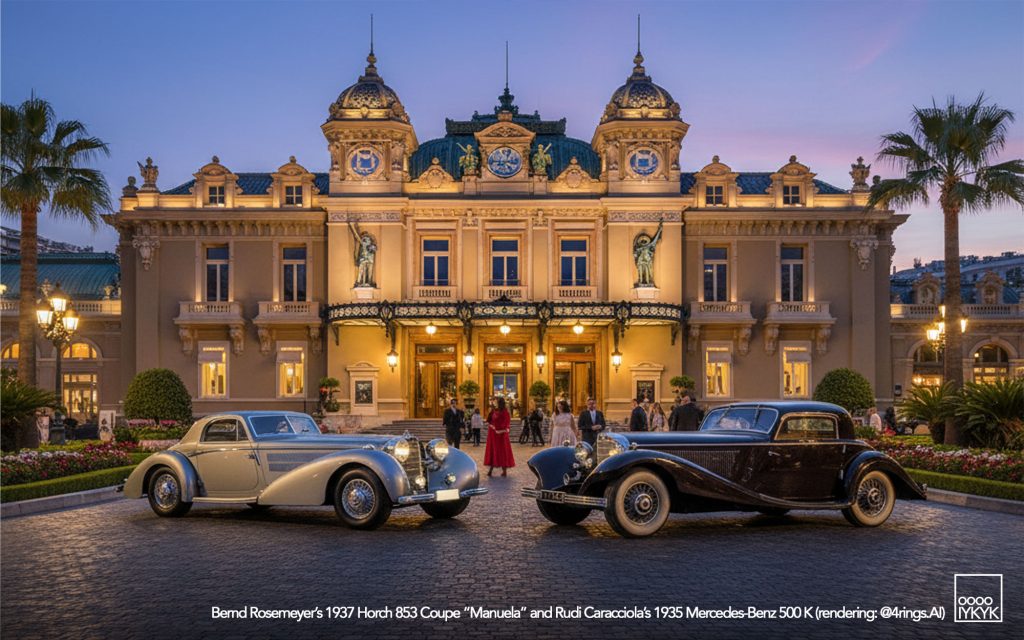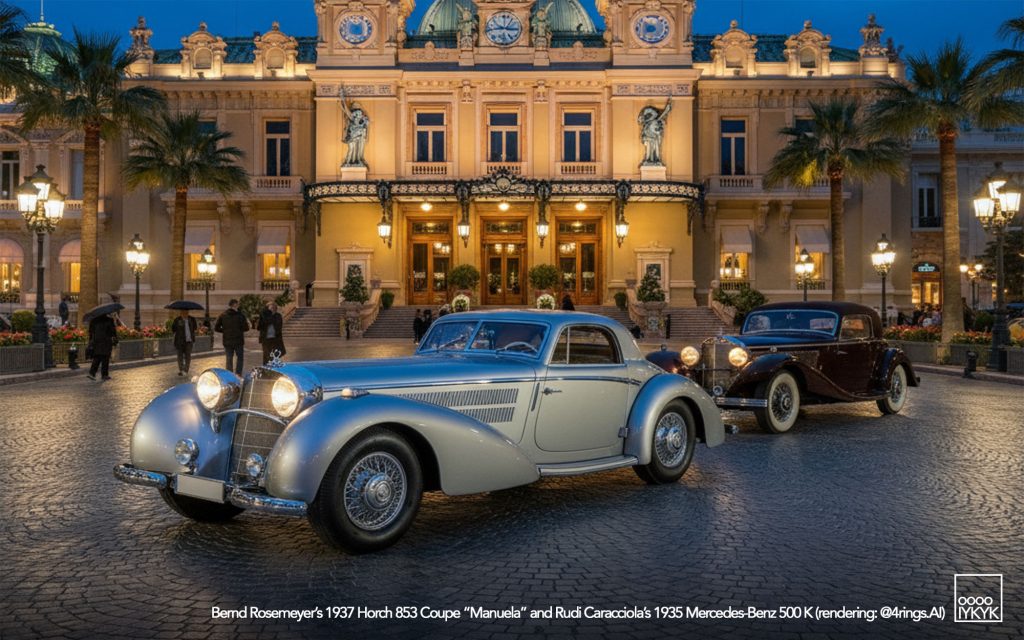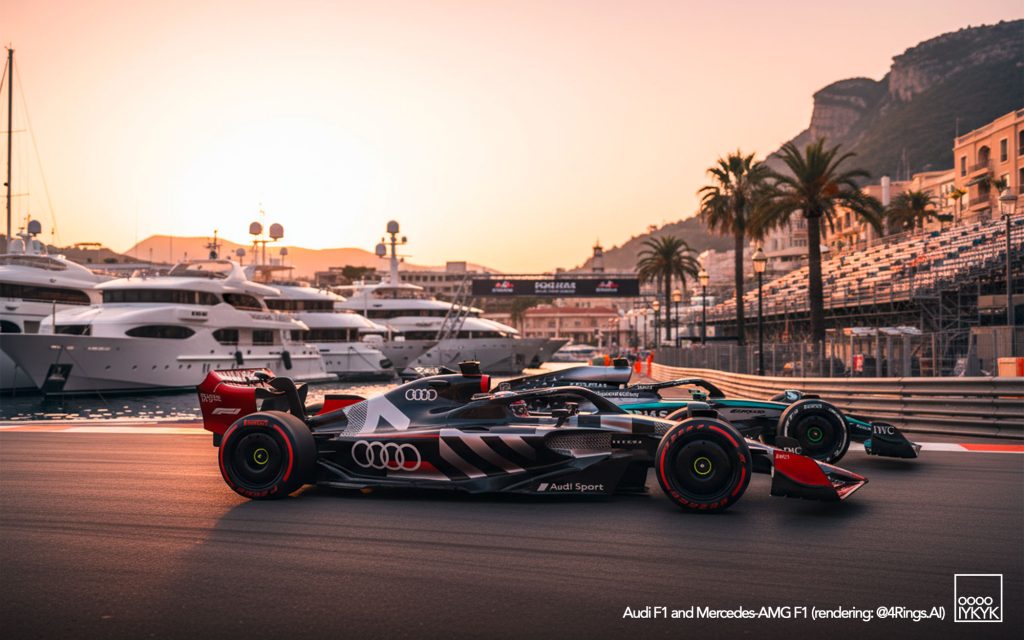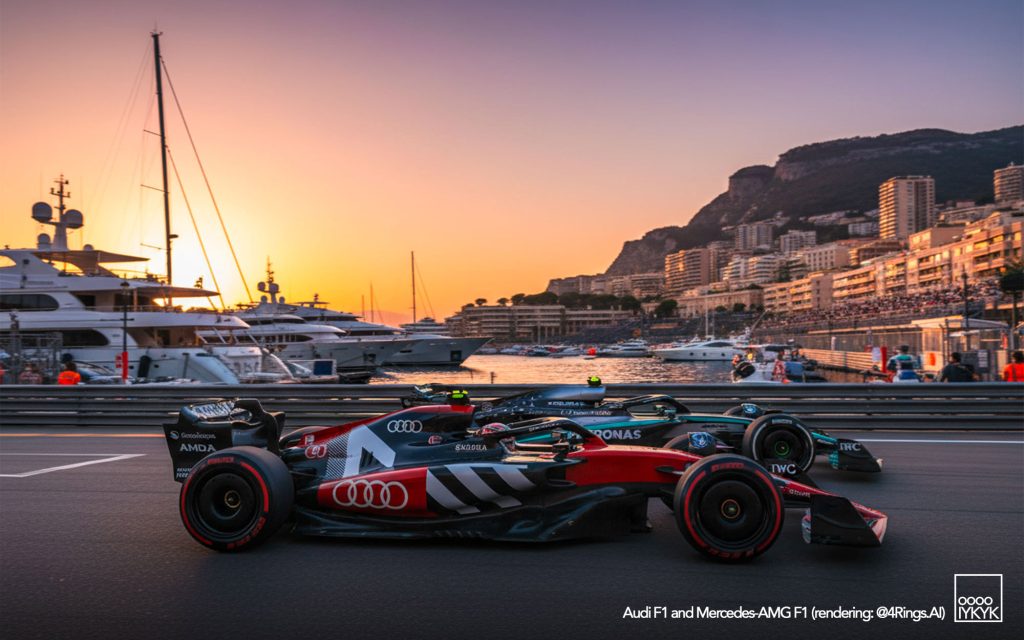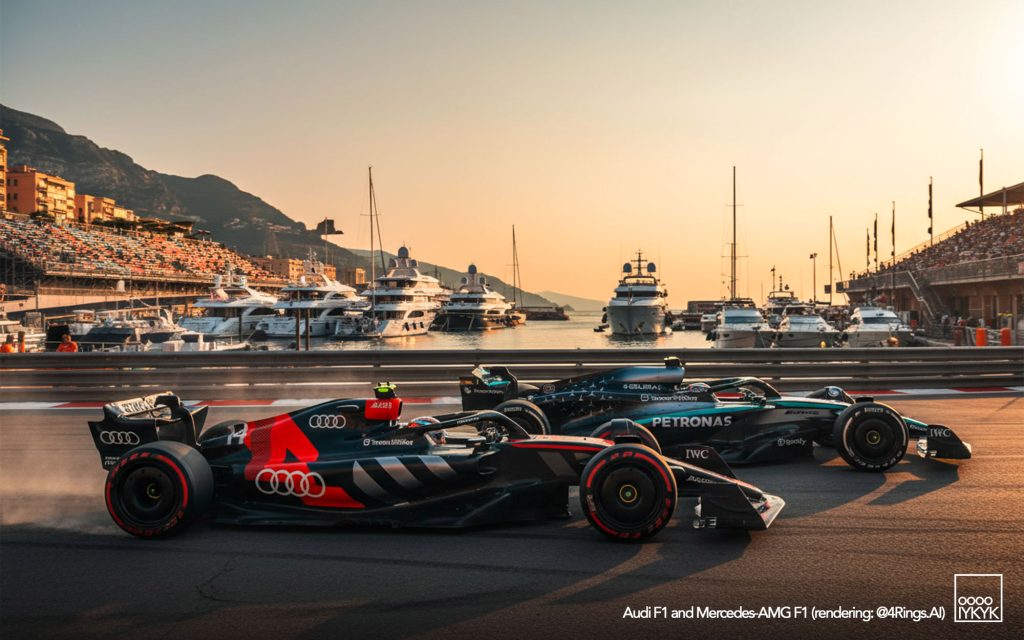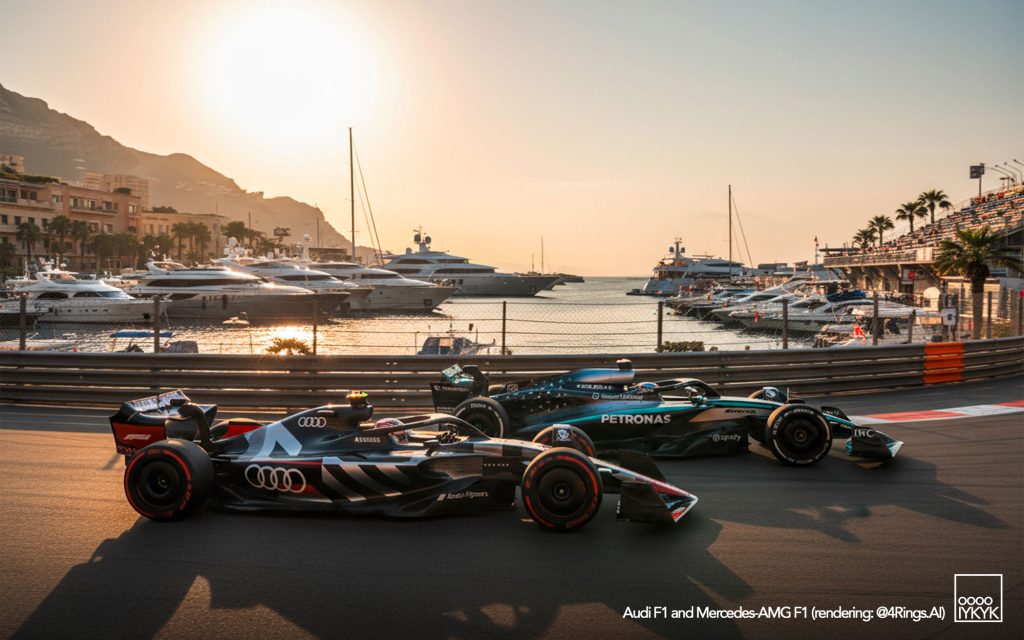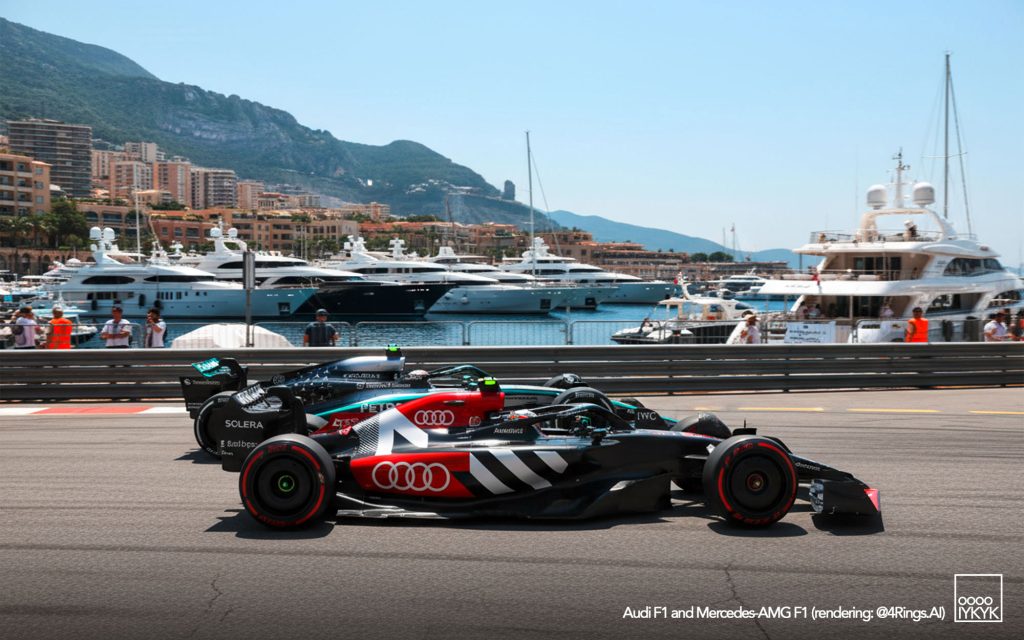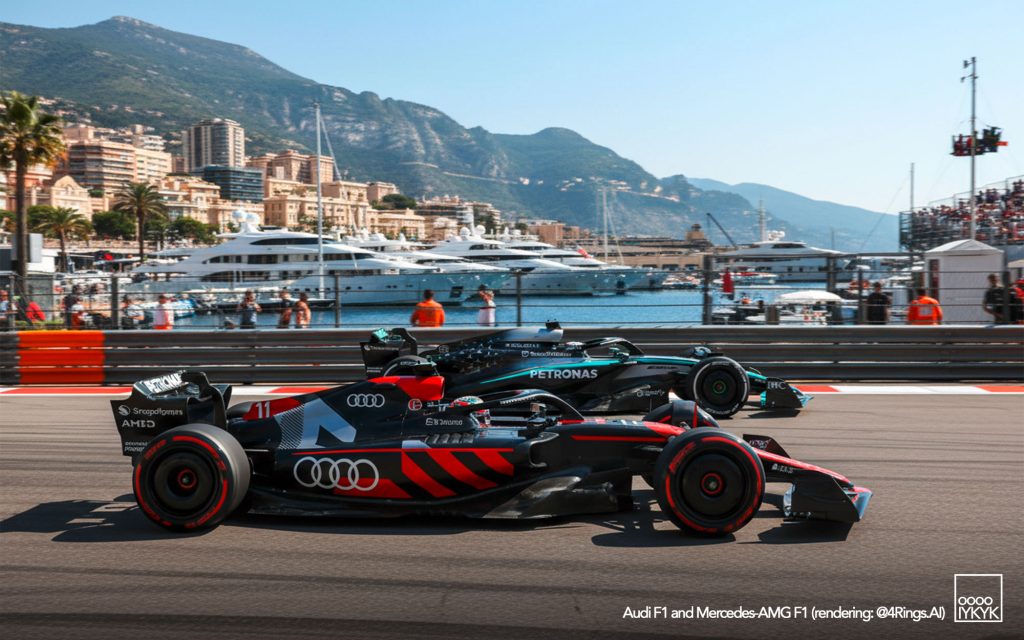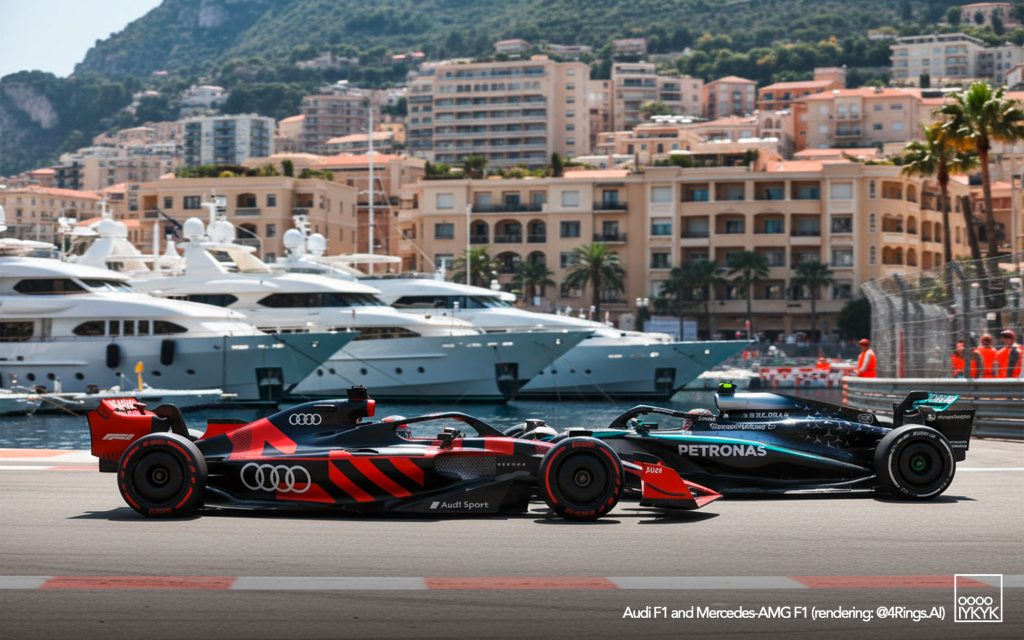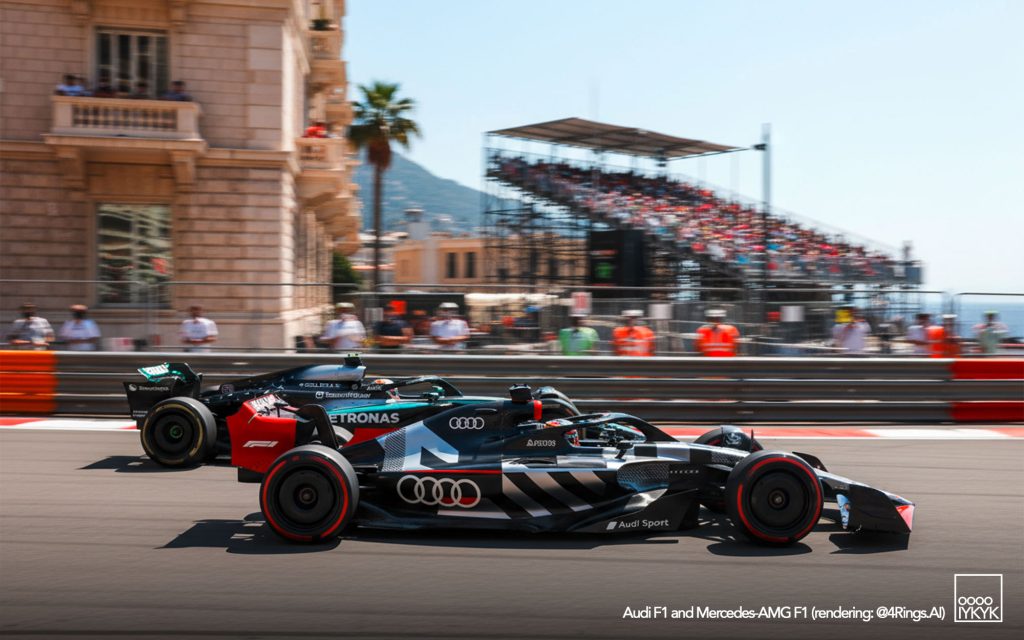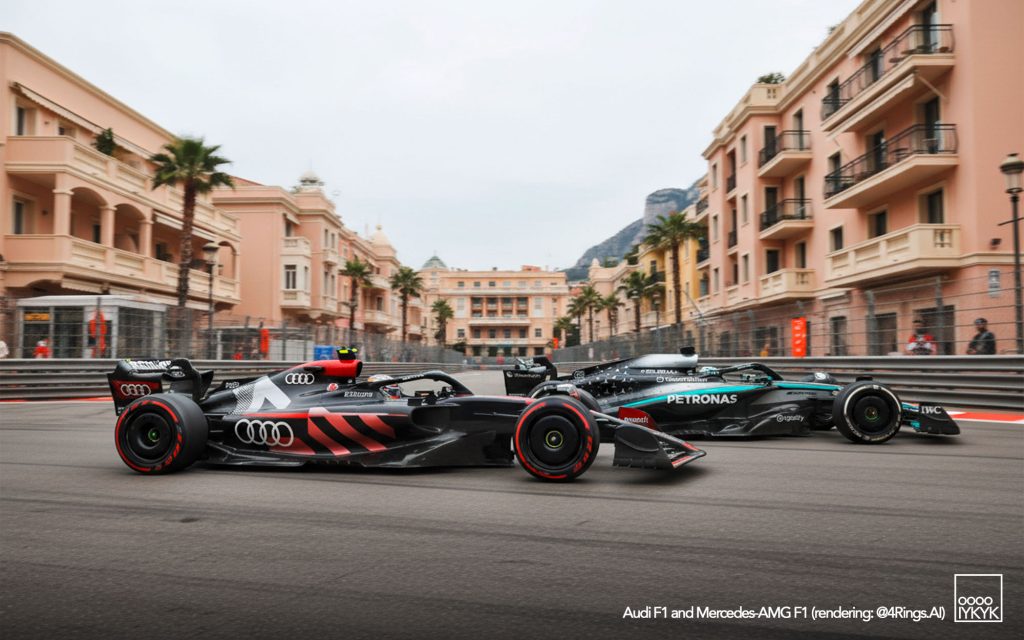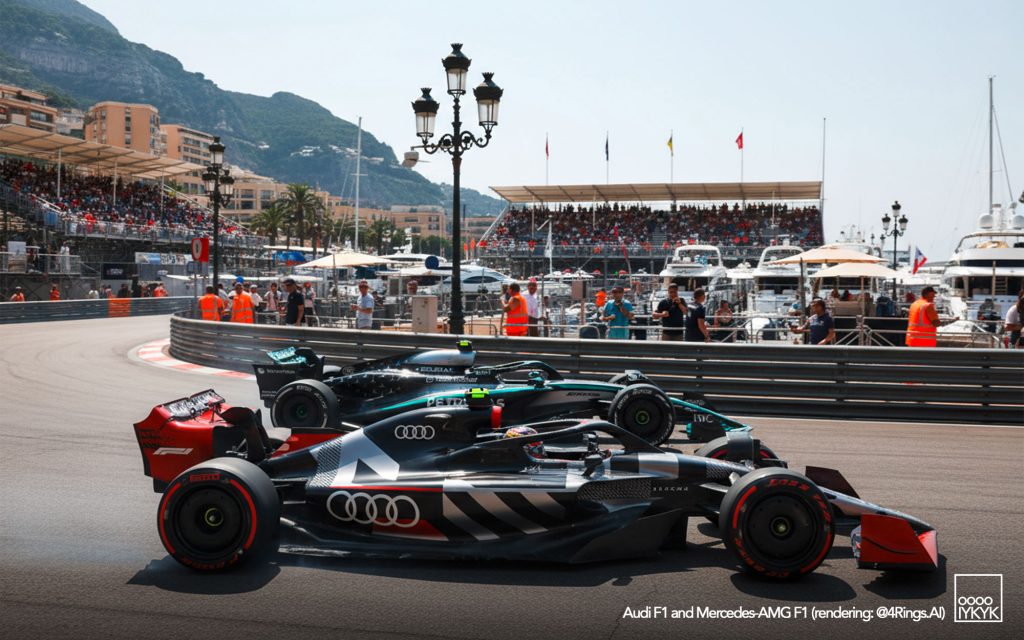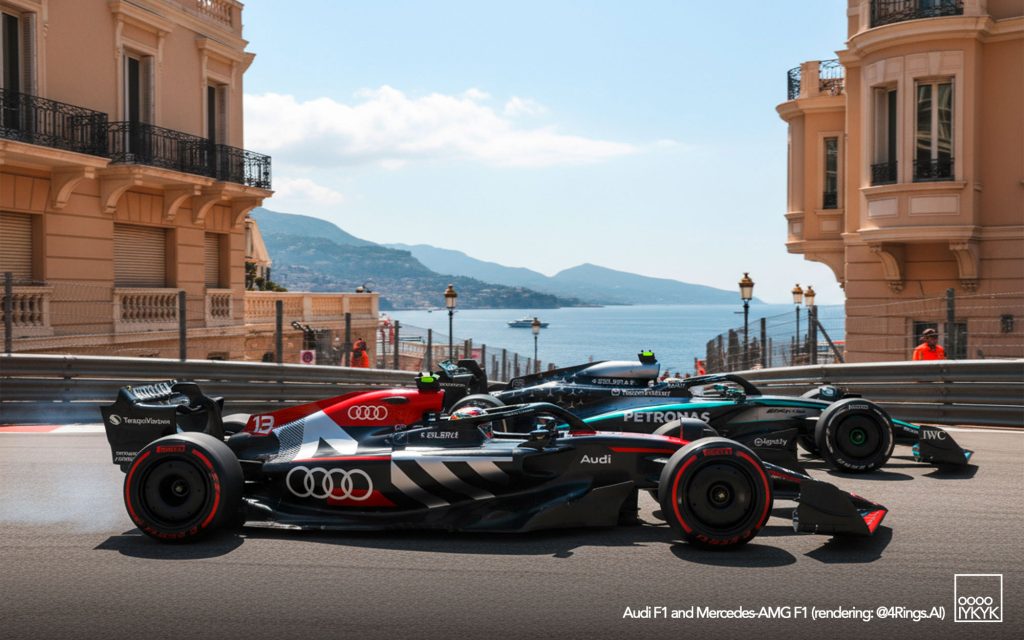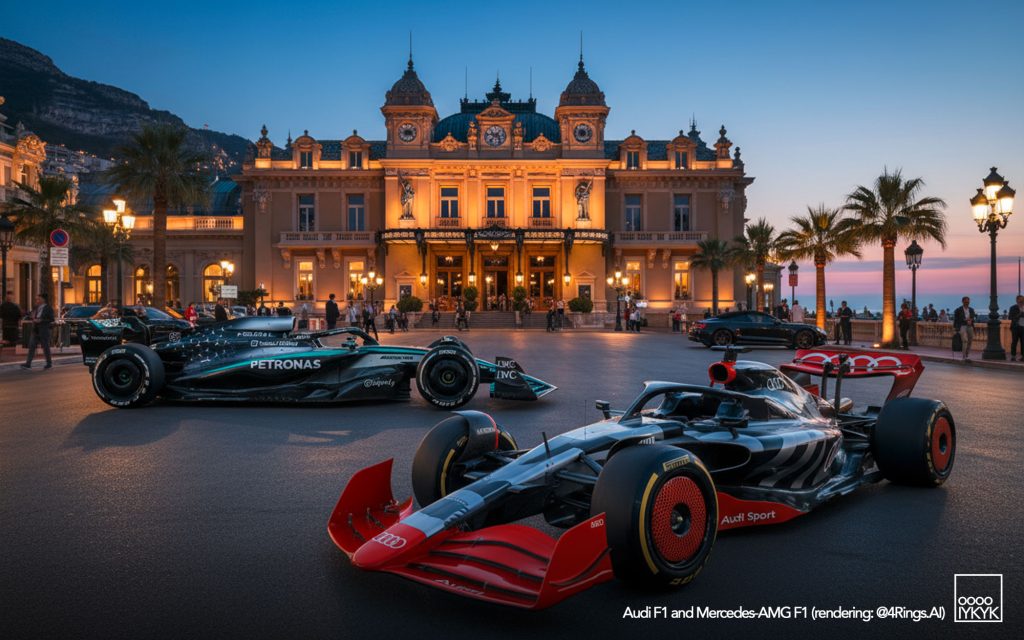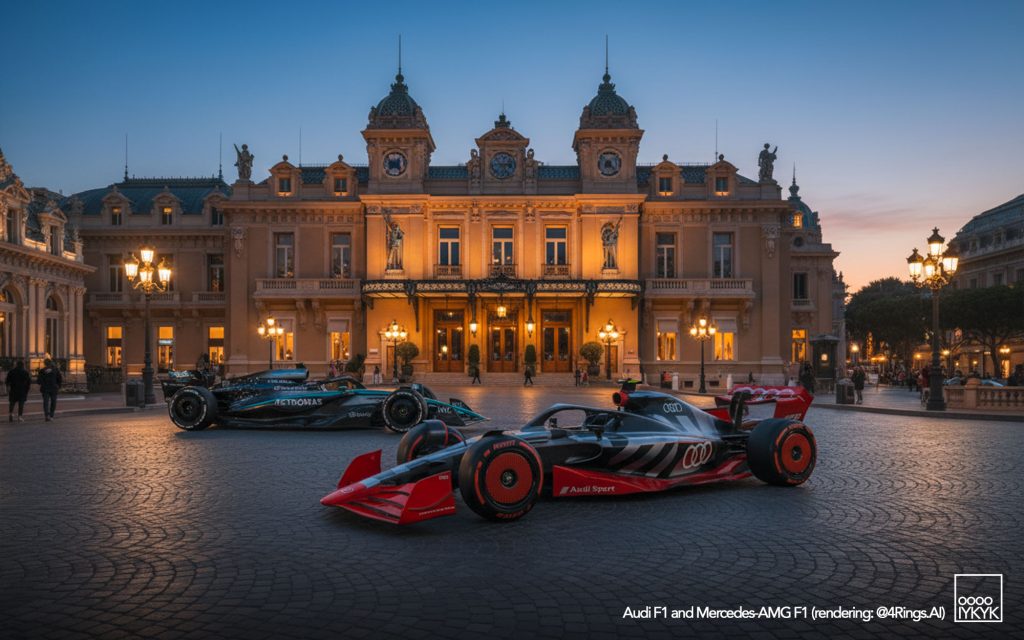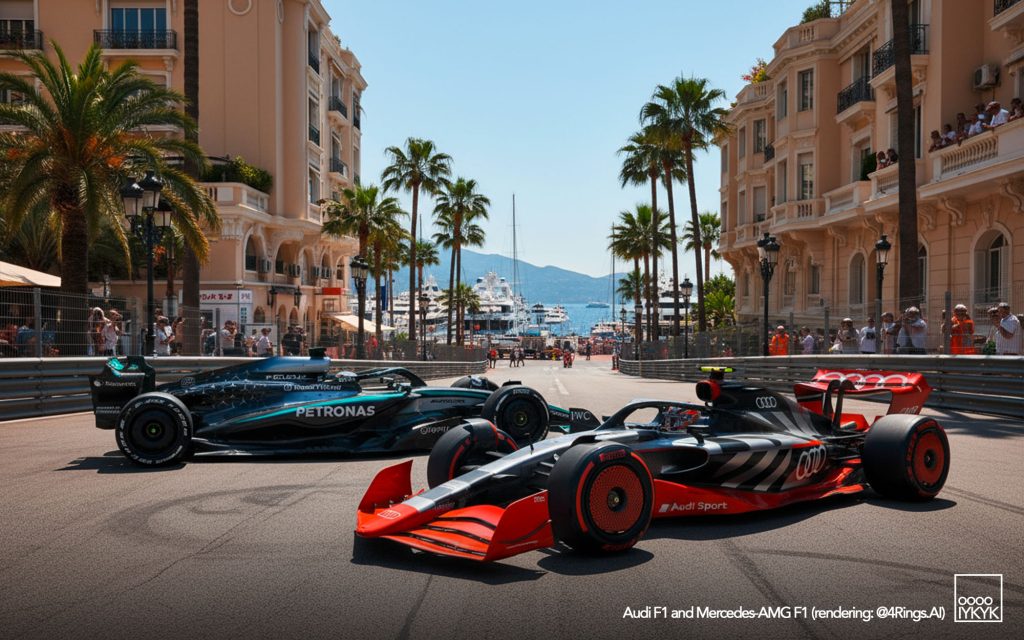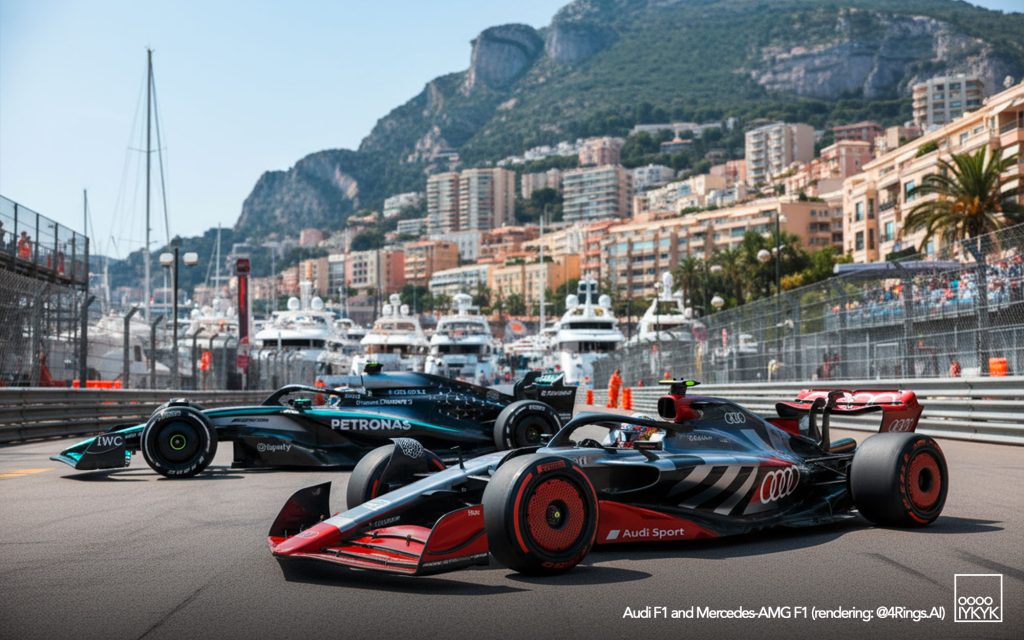Every so often, concept cars arrive that feel less like design studies and more like philosophical statements. Audi’s skysphere concept (2021) and Mercedes-Benz’s Vision Iconic (2025) are exactly that—timeless sculptural visions of what modern opulence looks like in the electric and autonomous age. Each takes cues not from specific past models, but from a time when luxury and performance intertwined—when road-going grand tourers were as dramatic as the drivers who raced for glory. In the 1930s, that spirit was personified by two legendary drivers: Bernd Rosemeyer of Auto Union and Rudolf Caracciola of Mercedes-Benz. Their personal cars, cars like the Horch 853 Coupé “Manuela” and the Mercedes-Benz 500 K Special Coupé, embodied the same idea these concepts channel today—unrestrained craftsmanship and technological ambition.
Bringing these cars together—the two concepts and their spiritual ancestors—would be physically impossible. Yet through the power of A.I. image generation, that’s precisely what’s been done here: imagining them side by side, set against the glittering terraces of Monaco. For visual harmony, the Audi skysphere now wears a silver hue—a nod to Rosemeyer’s beloved Manuela—contrasting beautifully with the darker Mercedes coupe.
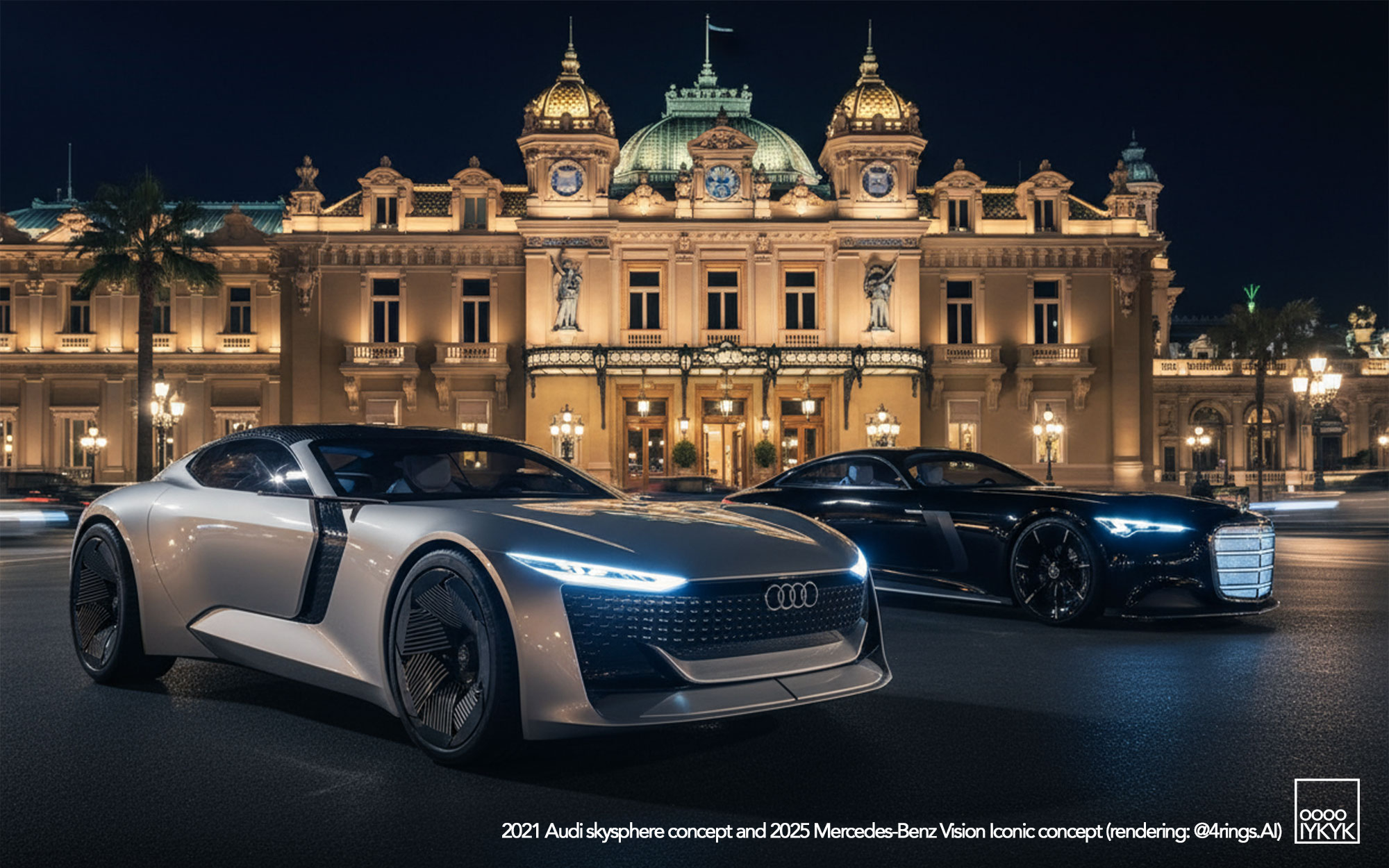
2021 AUDI SKYSPHERE CONCEPT
When the Audi skysphere debuted at Pebble Beach in August 2021, it previewed both Audi’s then future design language and also an idea. Audi called it a “vehicle experience device,” and for good reason: it could physically transform itself, both in form and in philosophy.
At the heart of the skysphere was a fully electric drivetrain and a variable-wheelbase architecture—a first of its kind. The system used electric actuators integrated into the subframe to lengthen or shorten the chassis by 250 millimeters, and lower ride height by up to 10 millimeters. In Sport mode, it shrinks to 4.94 meters and firms up its adaptive air suspension, offering sharper steering response through a steer-by-wire system. Switch to Grand Touring mode, and the chassis stretches to 5.19 meters, softening its damping, and retracting the steering wheel and pedals entirely, transitioning into a lounge-like autonomous cruiser.
Power was supplied by a single electric motor mounted on the rear axle, producing 465 kW (632 hp) and 750 Nm (553 lb-ft) of torque. It drew energy from an 80+ kWh battery integrated within the car’s central tunnel and underfloor structure. Audi quoted a range of over 500 km (310 miles) under WLTP standards, and performance figures included a 0–100 km/h sprint in just 4.0 seconds.
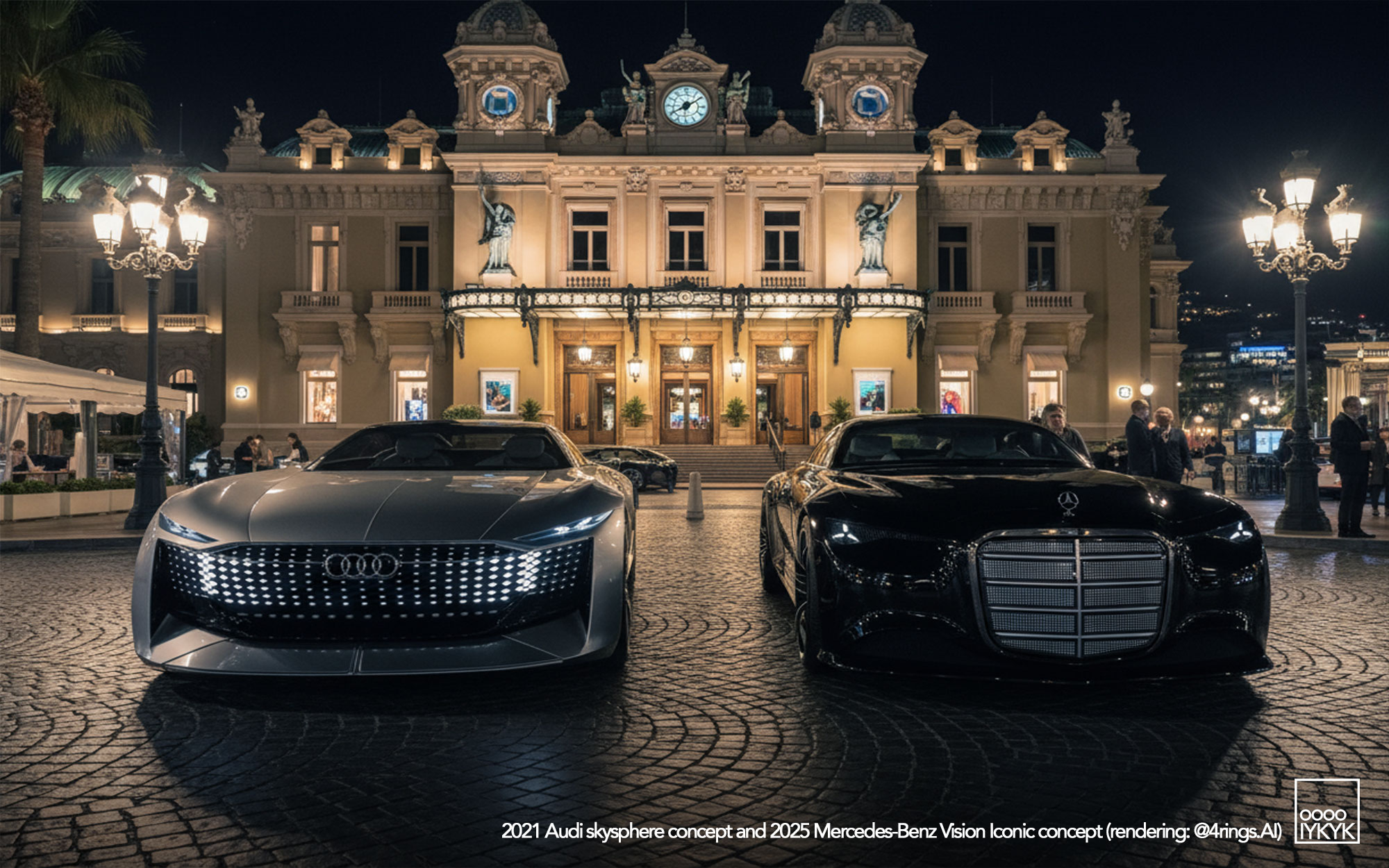
Underneath, the skysphere featured double-wishbone suspension front and rear, with adaptive air springs and predictive road scanning via sensors and GPS. Active rear steering complemented the car’s dual personality, tightening its turning circle in Sport mode or enhancing stability in long-wheelbase configuration.
The interior completed the transformation. The dashboard was an immersive digital panel that stretches across the cabin, turning from an instrument cluster to an entertainment hub in GT mode. Materials included sustainable microfibre, eucalyptus wood, and synthetic leather—a conscious move toward “responsible luxury.” The seats were upholstered in eco-processed leather and featured intricate stitching that referenced classic Audi Horch design cues.
Even though it harked pre-war Horch grand tourers, the skysphere wasn’t simply about nostalgia—it instead aimed to revisit that pre-war elegance in a modern way. With it, Audi wanted to redefine what a grand tourer could be when human emotion intersects with a more autonomous automotive experience than we have today..
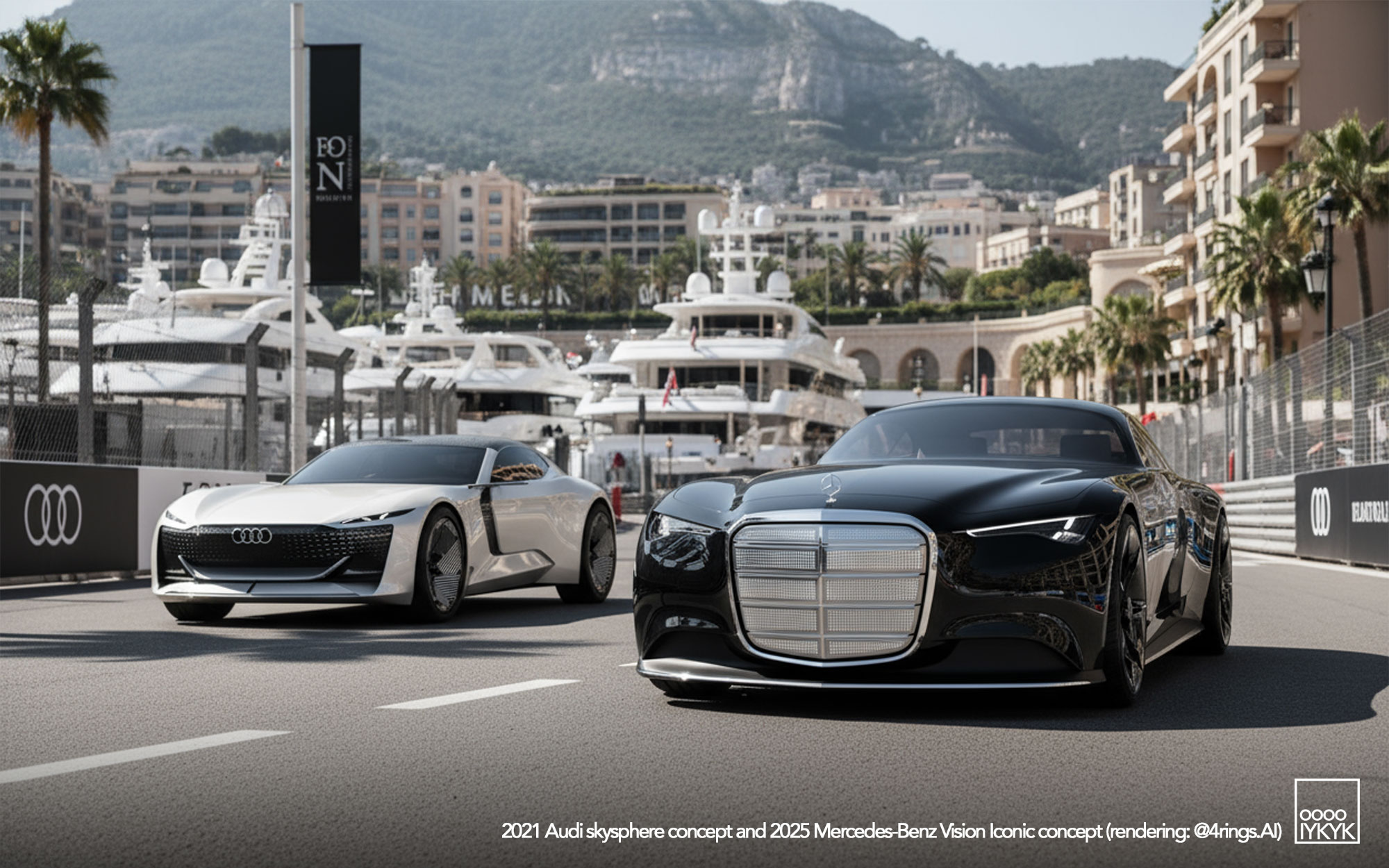
2025 MERCEDES-BENZ VISION ICONIC
Revealed just last week, the Mercedes-Benz Vision Iconic embodies what the three-pointed star calls “Art Deco reborn”.
The exterior dimensions alone are monumental: 5.3 meters in length, 2.1 meters wide, and rolling on 24-inch turbine-style wheels that fill the arches like jewelry. The body, constructed from carbon and recycled aluminum, wears a “Solar Alubeam” paint that actively generates energy. The finish integrates photovoltaic nanoparticles, creating what Mercedes terms a solar skin—capable of adding up to 12,000 kilometers of driving range per year under ideal sunlight.
Though Mercedes hasn’t confirmed technical specifications, insiders point to a dual-motor all-wheel-drive system producing approximately 600 kW (805 hp) and 1,000 Nm of torque, with an estimated 0–100 km/h time of under 3.5 seconds. The battery is believed to employ solid-state chemistry, allowing ultra-fast charging and improved packaging efficiency, though official capacity figures remain undisclosed.
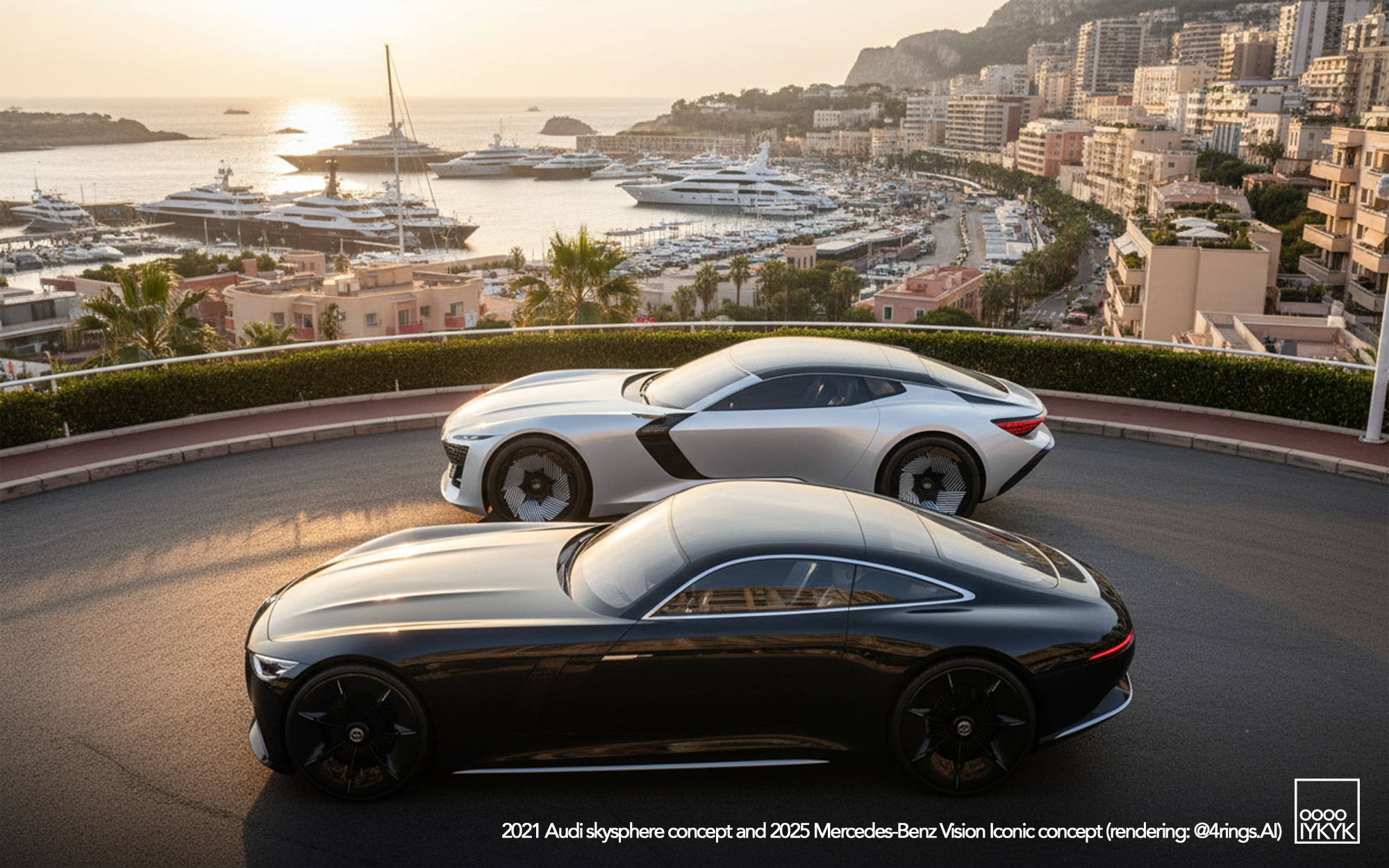
Inside, the Vision Iconic’s cabin offers a host of materials that hark that earlier era—deep blue velvet, brushed brass, crystal glass controls and backlit wood inlays. The “hyper-analog” dashboard merges traditional craftsmanship with the digital age: physical switches are replaced with glass surfaces that respond with haptic feedback, while a curved panoramic OLED screen blends seamlessly into the dash architecture.
Underneath the surface is Mercedes’ MB.OS platform with full Level 4 autonomous capability, supported by neuromorphic processors that mimic the neural structure of the human brain. Steering is handled through steer-by-wire, while the car’s air suspension reads the road using lidar and satellite data, adjusting ride height and damping.
Lighting is an important part of the design language: 1,200 individually addressable micro-LEDs form a reinterpretation of the traditional Mercedes grille, glowing dynamically depending on driving mode.
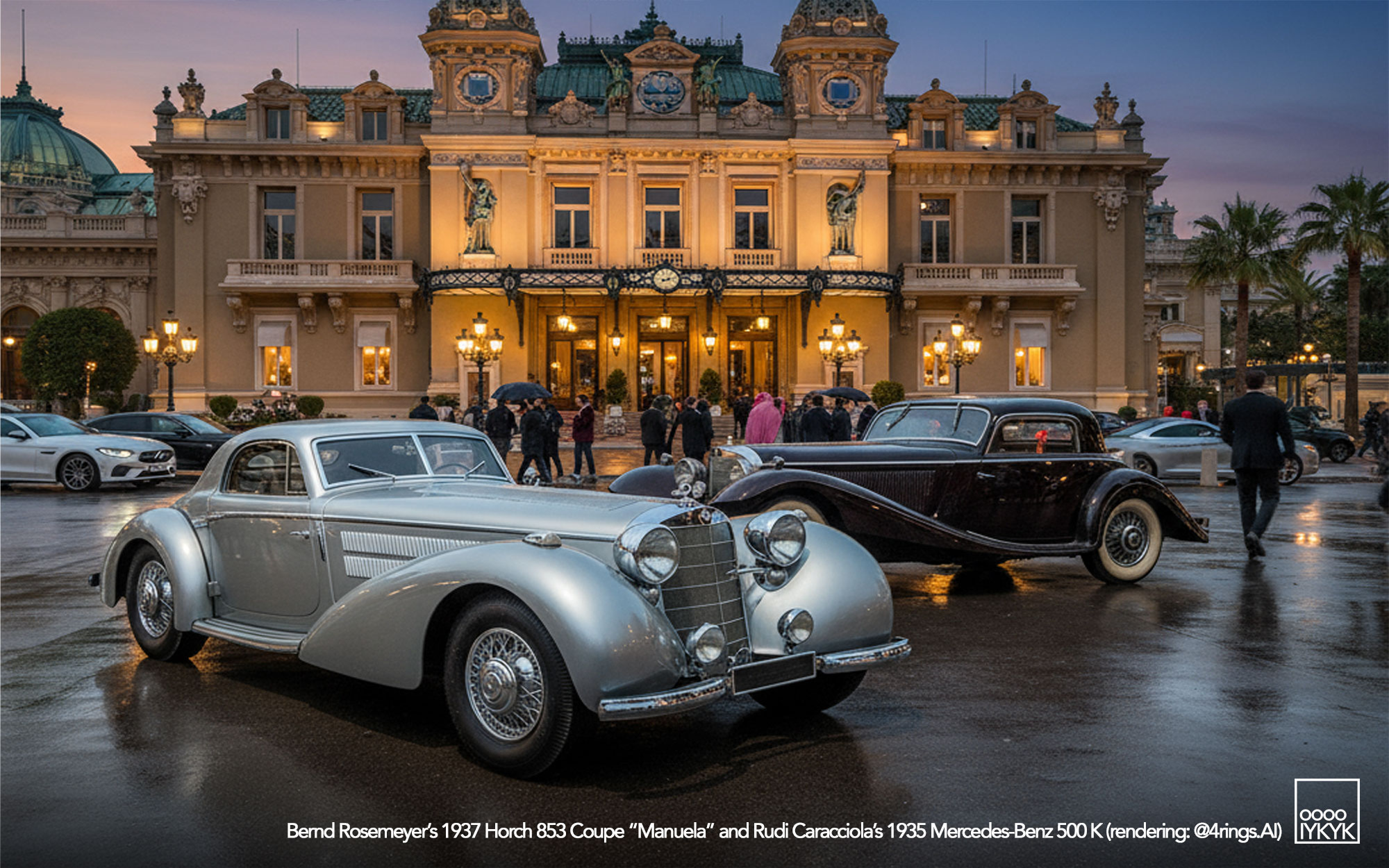
PRE-WAR GRAND TOURING ROSEMEYER’S HORCH 853 & CARACCIOLA’S MERCEDES-BENZ 500 K SPECIAL
The thread connecting these modern visions stretches back nearly ninety years to an era when luxury automobiles were some of the most theatrical.
In 1937, Auto Union’s champion driver Bernd Rosemeyer commissioned a Horch 853 Coupé from the Berlin coachbuilder Erdmann & Rossi. Painted silver to match his Auto Union Type C race car, the car embodied the same aerodynamic grace that defined his Grand Prix machines. Under its long hood sat a 5.0-liter straight-eight producing around 120 hp, capable of propelling the car to over 135 km/h—astounding for its era. Rosemeyer nicknamed it “Manuela” after his wife, aviatrix Elly Beinhorn, and drove it as a symbol of personal achievement rather than public victory.
His rival, Rudolf Caracciola, had his own on-brand grand-tourer – a 1935 500 K Special Coupé with bodywork by Sindelfingen. Its supercharged 5.0-liter inline-eight could produce 160 hp with the blower engaged, pushing the coupe to nearly 160 km/h.
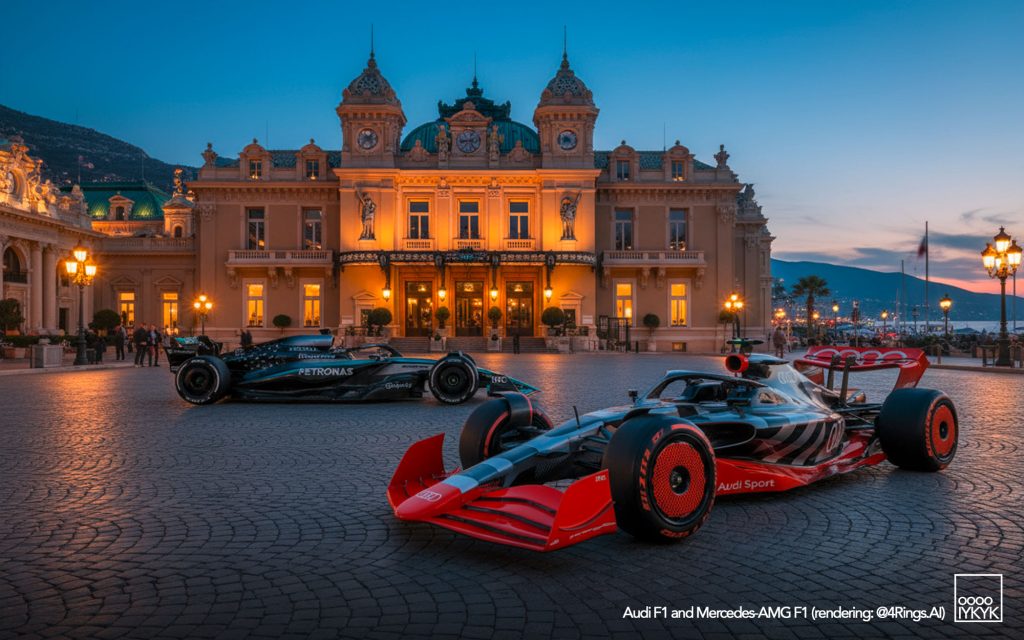
LUXURY, LEGACY & THE MODERN PARALLEL
The skysphere and Vision Iconic don’t mimic these pre-war cars; they echo their theme. Both reinterpret what it means to travel in the upper atmosphere of grand touring luxury—where performance and indulgence coexist.
The skysphere seems to channel Rosemeyer’s passion for personal expression and dynamic freedom—its adjustable wheelbase and dual personalities fitting the upstart position that Auto Union occupied at the time and Audi remains today. The Vision Iconic, meanwhile, embraces Caracciola’s sense of command and status, merging precision engineering with authority in a very Mercedes-Benz sort of way.
In both cases, the lineage seems to fit: a celebration of designers at these two storied brands to merge beauty and speed into a modern world where the automobile is quickly evolving. And in both cases, these brands remind us that even in the electrified future, emotion remains a most important part of the equation that seems so quickly forgotten when viewed through the schema of appliance-like EV crossovers.
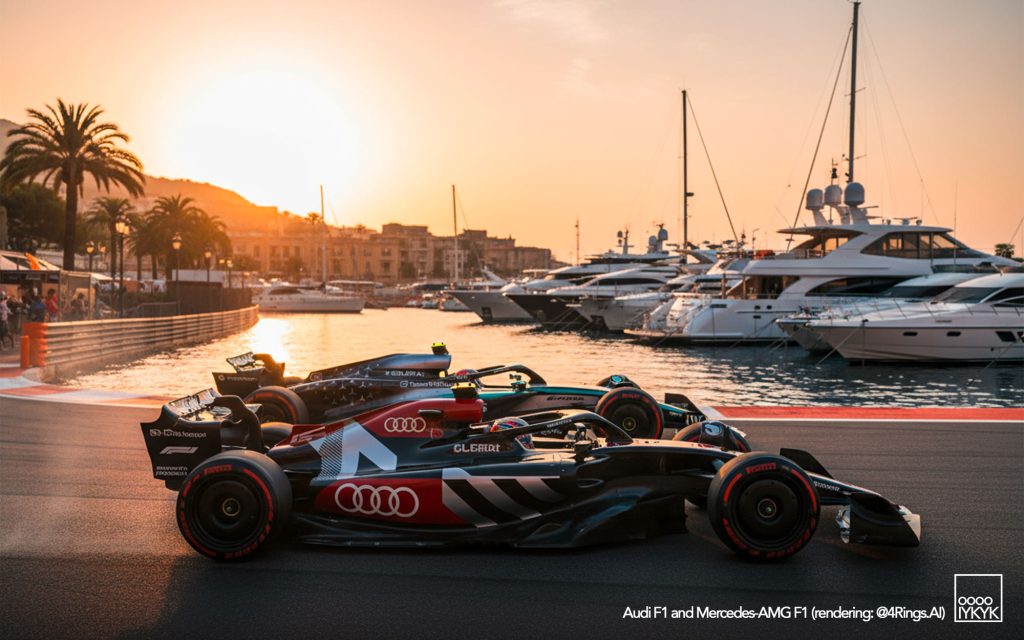
AI TABLEAU AN IMPOSSIBLE GATHERING
To assemble all four of these cars—the skysphere, Vision Iconic, the Horch 853 known to Rosemeyer as “Manuela,” and Caracciola’s Mercedes 500 K—would be logistically impossible. Two are single concept showpieces; the other pair are irreplaceable pieces of history. Now, throw in a pair of each brand’s F1 cars for good measure.
Through the power of A.I., I’ve created the impossible via the combining of press images of the two cars: an imagined gathering of past and future. The Audi skysphere, rendered in silver here for a fresh new take of that car, stands beside the deep metallic Vision Iconic in and around Monaco. Also part of this virtual gathering, the Horch and 500 K represent ghosts of an age when this sort of craftsmanship ruled and racing heroes drove these legends home. Out on track, the 2025-spec Mercedes-AMG F1 W16 races by with the 2022 Audi F1 display car that’s the only hint of what we’ll see next year from the four rings until the final car is released sometime in the coming months.
These are fantasy images that bridge nearly a century—proving that while technology evolves, fascination does not.
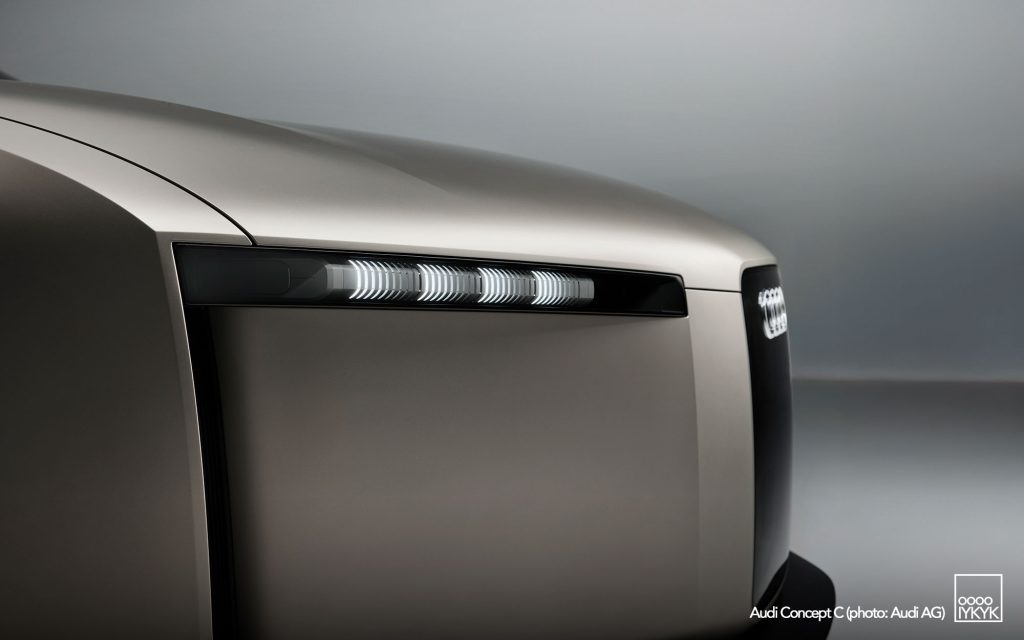
SIDE NOTE
Four years on from the debut of the skysphere concept, Audi stands in a very different place. The brand of the four rings has entered a new design era—one led by Chief Creative Officer Massimo Frascella, who calls the current philosophy “The Radical Next.” Where the skysphere championed fluid sensuality and elegance, the new approach is sharper, more architectural, and distinctly forward-looking.
The Audi Concept C, revealed in September, embodies that shift. Designed as the next evolution of Audi’s electric sportscar lineage, it introduces adesign language built around tighter surfacing, minimalist proportions, and a bolder front identity. The car signals a clean break from the sculptural lines of the Skysphere, replacing them with tension and structure—a philosophy intended to prepare the brand for its new generation of vehicles.
Spiritually, though, the move feels familiar. In the early 1990s, Audi underwent a similar transformation—from the opulent, polished aluminum 1991 Avus quattro concept with its twelve-cylinder engine to the more attainable yet still iconic Audi TT that followed later in the decade. The Concept C plays the same role: a high-art provocation that paves the way for something more tangible and affordable.
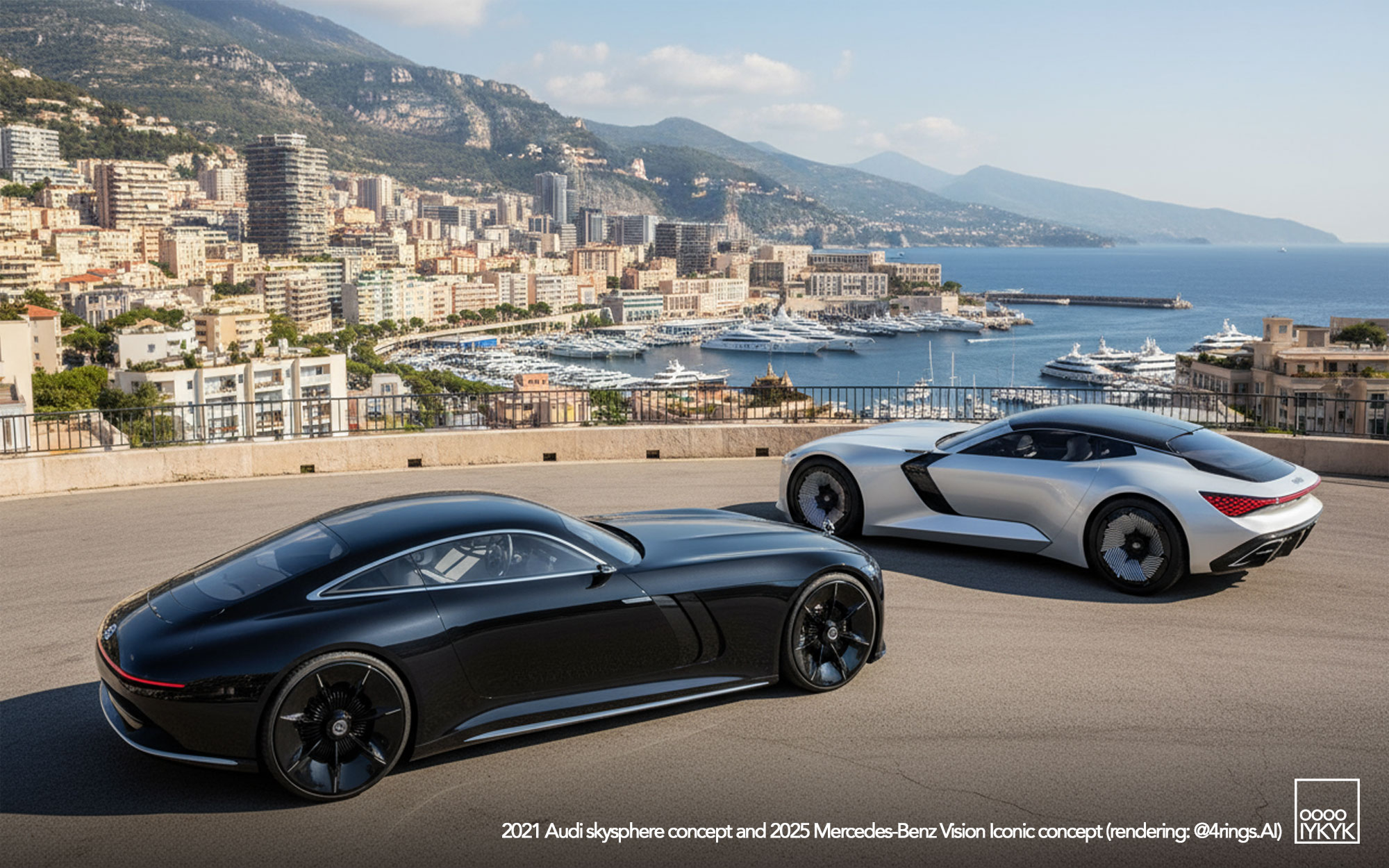
THE ART OF TIMELESS EXCESS
From Rosemeyer’s Horch to Caracciola’s 500 K, from the skysphere to the Vision Iconic, the Mercedes-AMG F1 W16 to Audi F1’s teaser and now with the Concept C, one theme that seems to pierce through it all like a Silver Arrow: the pursuit of beautiful automotive design. Whether powered by supercharged eight-cylinders or the brutal push of silent electrics, it is important that this essence continues.
PHOTO GALLERY
